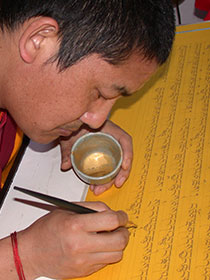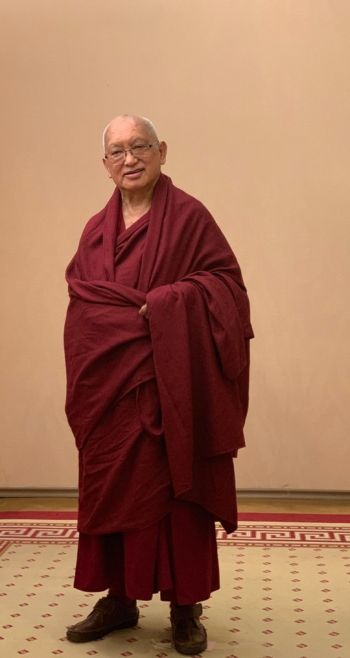- Home
- FPMT Homepage
Foundation for the Preservation of the Mahayana Tradition
The FPMT is an organization devoted to preserving and spreading Mahayana Buddhism worldwide by creating opportunities to listen, reflect, meditate, practice and actualize the unmistaken teachings of the Buddha and based on that experience spreading the Dharma to sentient beings. We provide integrated education through which people’s minds and hearts can be transformed into their highest potential for the benefit of others, inspired by an attitude of universal responsibility and service. We are committed to creating harmonious environments and helping all beings develop their full potential of infinite wisdom and compassion. Our organization is based on the Buddhist tradition of Lama Tsongkhapa of Tibet as taught to us by our founders Lama Thubten Yeshe and Lama Thubten Zopa Rinpoche.
- Willkommen
Die Stiftung zur Erhaltung der Mahayana Tradition (FPMT) ist eine Organisation, die sich weltweit für die Erhaltung und Verbreitung des Mahayana-Buddhismus einsetzt, indem sie Möglichkeiten schafft, den makellosen Lehren des Buddha zuzuhören, über sie zur reflektieren und zu meditieren und auf der Grundlage dieser Erfahrung das Dharma unter den Lebewesen zu verbreiten.
Wir bieten integrierte Schulungswege an, durch denen der Geist und das Herz der Menschen in ihr höchstes Potential verwandelt werden zum Wohl der anderen – inspiriert durch eine Haltung der universellen Verantwortung und dem Wunsch zu dienen. Wir haben uns verpflichtet, harmonische Umgebungen zu schaffen und allen Wesen zu helfen, ihr volles Potenzial unendlicher Weisheit und grenzenlosen Mitgefühls zu verwirklichen.
Unsere Organisation basiert auf der buddhistischen Tradition von Lama Tsongkhapa von Tibet, so wie sie uns von unseren Gründern Lama Thubten Yeshe und Lama Thubten Zopa Rinpoche gelehrt wird.
- Bienvenidos
La Fundación para la preservación de la tradición Mahayana (FPMT) es una organización que se dedica a preservar y difundir el budismo Mahayana en todo el mundo, creando oportunidades para escuchar, reflexionar, meditar, practicar y actualizar las enseñanzas inconfundibles de Buda y en base a esa experiencia difundir el Dharma a los seres.
Proporcionamos una educación integrada a través de la cual las mentes y los corazones de las personas se pueden transformar en su mayor potencial para el beneficio de los demás, inspirados por una actitud de responsabilidad y servicio universales. Estamos comprometidos a crear ambientes armoniosos y ayudar a todos los seres a desarrollar todo su potencial de infinita sabiduría y compasión.
Nuestra organización se basa en la tradición budista de Lama Tsongkhapa del Tíbet como nos lo enseñaron nuestros fundadores Lama Thubten Yeshe y Lama Zopa Rinpoche.
A continuación puede ver una lista de los centros y sus páginas web en su lengua preferida.
- Bienvenue
L’organisation de la FPMT a pour vocation la préservation et la diffusion du bouddhisme du mahayana dans le monde entier. Elle offre l’opportunité d’écouter, de réfléchir, de méditer, de pratiquer et de réaliser les enseignements excellents du Bouddha, pour ensuite transmettre le Dharma à tous les êtres. Nous proposons une formation intégrée grâce à laquelle le cœur et l’esprit de chacun peuvent accomplir leur potentiel le plus élevé pour le bien d’autrui, inspirés par le sens du service et une responsabilité universelle. Nous nous engageons à créer un environnement harmonieux et à aider tous les êtres à épanouir leur potentiel illimité de compassion et de sagesse. Notre organisation s’appuie sur la tradition guéloukpa de Lama Tsongkhapa du Tibet, telle qu’elle a été enseignée par nos fondateurs Lama Thoubtèn Yéshé et Lama Zopa Rinpoché.
Visitez le site de notre Editions Mahayana pour les traductions, conseils et nouvelles du Bureau international en français.
Voici une liste de centres et de leurs sites dans votre langue préférée
- Benvenuto
L’FPMT è un organizzazione il cui scopo è preservare e diffondere il Buddhismo Mahayana nel mondo, creando occasioni di ascolto, riflessione, meditazione e pratica dei perfetti insegnamenti del Buddha, al fine di attualizzare e diffondere il Dharma fra tutti gli esseri senzienti.
Offriamo un’educazione integrata, che può trasformare la mente e i cuori delle persone nel loro massimo potenziale, per il beneficio di tutti gli esseri, ispirati da un’attitudine di responsabilità universale e di servizio.
Il nostro obiettivo è quello di creare contesti armoniosi e aiutare tutti gli esseri a sviluppare in modo completo le proprie potenzialità di infinita saggezza e compassione.
La nostra organizzazione si basa sulla tradizione buddhista di Lama Tsongkhapa del Tibet, così come ci è stata insegnata dai nostri fondatori Lama Thubten Yeshe e Lama Zopa Rinpoche.
Di seguito potete trovare un elenco dei centri e dei loro siti nella lingua da voi prescelta.
- 欢迎 / 歡迎
简体中文
“护持大乘法脉基金会”( 英文简称:FPMT。全名:Foundation for the Preservation of the Mahayana Tradition) 是一个致力于护持和弘扬大乘佛法的国际佛教组织。我们提供听闻,思维,禅修,修行和实证佛陀无误教法的机会,以便让一切众生都能够享受佛法的指引和滋润。
我们全力创造和谐融洽的环境, 为人们提供解行并重的完整佛法教育,以便启发内在的环宇悲心及责任心,并开发内心所蕴藏的巨大潜能 — 无限的智慧与悲心 — 以便利益和服务一切有情。
FPMT的创办人是图腾耶喜喇嘛和喇嘛梭巴仁波切。我们所修习的是由两位上师所教导的,西藏喀巴大师的佛法传承。
繁體中文
護持大乘法脈基金會”( 英文簡稱:FPMT。全名:Found
ation for the Preservation of the Mahayana Tradition ) 是一個致力於護持和弘揚大乘佛法的國際佛教組織。我們提供聽聞, 思維,禪修,修行和實證佛陀無誤教法的機會,以便讓一切眾生都能 夠享受佛法的指引和滋潤。 我們全力創造和諧融洽的環境,
為人們提供解行並重的完整佛法教育,以便啟發內在的環宇悲心及責 任心,並開發內心所蘊藏的巨大潛能 — 無限的智慧與悲心 – – 以便利益和服務一切有情。 FPMT的創辦人是圖騰耶喜喇嘛和喇嘛梭巴仁波切。
我們所修習的是由兩位上師所教導的,西藏喀巴大師的佛法傳承。 察看道场信息:
- FPMT Homepage
- News/Media
-
- Study & Practice
-
-
- About FPMT Education Services
- Latest News
- Programs
- New to Buddhism?
- Buddhist Mind Science: Activating Your Potential
- Heart Advice for Death and Dying
- Discovering Buddhism
- Living in the Path
- Exploring Buddhism
- FPMT Basic Program
- FPMT Masters Program
- FPMT In-Depth Meditation Training
- Maitripa College
- Lotsawa Rinchen Zangpo Translator Program
- Universal Education for Compassion & Wisdom
- Online Learning Center
-
- Prayers & Practice Materials
- Overview of Prayers & Practices
- Full Catalogue of Prayers & Practice Materials
- Explore Popular Topics
- Benefiting Animals
- Chenrezig Resources
- Death & Dying Resources
- Lama Chopa (Guru Puja)
- Lama Zopa Rinpoche: Compendium of Precious Instructions
- Lama Zopa Rinpoche: Life Practice Advice
- Lama Zopa Rinpoche Practice Series
- Lamrim Resources
- Mantras
- Prayer Book Updates
- Purification Practices
- Sutras
- Thought Transformation (Lojong)
- Audio Materials
- Dharma Dates - Tibetan Calendar
- Translation Services
- Publishing Services
- Ways to Offer Support
- Prayers & Practice Materials
-
- Teachings and Advice
- Find Teachings and Advice
- Lama Zopa Rinpoche Advice Page
- Lama Zopa Rinpoche: Compendium of Precious Instructions
- Lama Zopa Rinpoche Video Teachings
- ༧སྐྱབས་རྗེ་བཟོད་པ་རིན་པོ་ཆེ་མཆོག་ནས་སྩལ་བའི་བཀའ་སློབ་བརྙན་འཕྲིན།
- Podcasts
- Lama Yeshe Wisdom Archive
- Buddhism FAQ
- Dharma for Young People
- Resources on Holy Objects
- Teachings and Advice
-
-
*If a menu item has a submenu clicking once will expand the menu clicking twice will open the page.
-
-
- Centers
-
- Teachers
-
- Projects
-
-
-
-
*If a menu item has a submenu clicking once will expand the menu clicking twice will open the page.
-
-
- FPMT
-
-
-
-
-
Realize that the nature of your mind is different from that of the flesh and bone of your physical body. Your mind is like a mirror, reflecting everything without discrimination. If you have understanding-wisdom, you can control the kind of reflection that you allow into the mirror of your mind.
Lama Thubten Yeshe
-
-
-
- Shop
-
-
-
The Foundation Store is FPMT’s online shop and features a vast selection of Buddhist study and practice materials written or recommended by our lineage gurus. These items include homestudy programs, prayers and practices in PDF or eBook format, materials for children, and other resources to support practitioners.
Items displayed in the shop are made available for Dharma practice and educational purposes, and never for the purpose of profiting from their sale. Please read FPMT Foundation Store Policy Regarding Dharma Items for more information.
-
-
FPMT Community: Stories & News
14
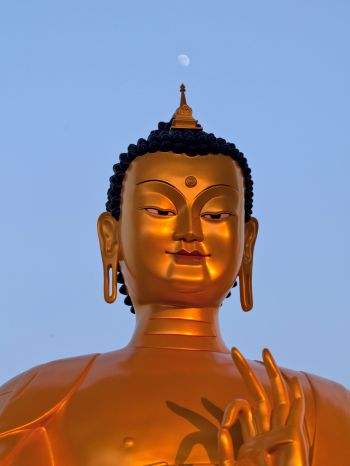
A scale replica of the Maitreya Buddha statue to be built, Kushinagar, India, 2013. Photo by Andy Melnic.
The creation of Holy Objects for World Peace is an important aspect of Lama Zopa Rinpoche’s charitable work as carried out by FPMT Inc. More specifically, Rinpoche envisions the creation of many statues of Maitreya Buddha around the world. Currently, there are two separate FPMT projects to build very large Maitreya Buddha statues in India, one based in Bodhgaya, Bihar, and one based in Kushinagar, Uttar Pradesh.
The project to build a Maitreya Buddha statue in Kushinagar is overseen by the Maitreya Project Trust (MPT). During the week of November 12, Indian newspapers were reporting that the Uttar Pradesh cabinet had approved the cancellation of the Memorandum of Understanding/Lease Agreement between MPT and the Uttar Pradesh government. This action concerns 250 acres of land that the Uttar Pradesh government has offered to the project.
The director of the Maitreya Buddha Project Kushinagar, which is the project overseen by MPT, said that the news of the cancellation came as a complete surprise to the project and that they first learned about the cabinet’s action through a Times of India article. The article quoted government officials claiming that the MPT had breached the terms of the Memorandum of Understanding (MOU).
The Maitreya Buddha Project Kushinagar updated FPMT Inc. about the status of the project and the work that has been done related to the MOU (see below). The project strongly disputed the government officials’ claims. Their update outlines how the project has been engaged in consistent work to meet the terms of the agreement and the requirements of other government agencies. The project also points out that the MOU included a requirement of a 90-day notice period should the UP government terminate the MOU, which has not been observed.
Since 2016, when the land agreement between the MPT and the Uttar Pradesh government was signed, the project has built a fence around the project’s land. There has been a feng shui evaluation undertaken by an international team, which will be integrated into the master plan. And senior Geshes and Sangha have conducted a ground breaking ceremony on the land.
In addition for several years now, humanitarian activities have been ongoing, including the distribution of blankets and mosquito nets. A mobile medical clinic sponsored by the project has also been serving people in need in rural areas.
The Maitreya Project Trust is currently working to get a complete understanding of the current situation and remains committed to creating a large Maitreya statue in Kushinigar and setting up social and education programs in connection with it.
Key points from the Maitreya Buddha Project Kushinagar update are outlined below:
- The Uttar Pradesh cabinet’s decision regarding the Memorandum of Understanding (MOU) came as a surprise to the Maitreya Project Trust (MPT), who first learned about the decision through a Times of India article. There was no prior official communication of this given to MPT, despite one of the MOU’s provisions requiring that the government issue a legal termination with a 90-day notice period.
- MPT strongly disagrees with the reported statements of the Uttar Pradesh government officials that say that MPT breached the terms of the MOU.
- Since the signing of the MOU in August 2016, MPT has been in touch with the administrative authorities frequently, working with them to complete the process of transferring the land.
- MPT succeeded in getting the authorities to survey the land in April 2018, with this survey completed in June 2018.
- On completion of the survey, MPT became aware that out of the 250 acres of land that was supposed to be conveyed to MPT as part of the MOU, only 176 acres were acquired by the government while 74 acres were not acquired.
- Another issue uncovered by the survey was that the 176 acres acquired by the government and conveyed by way of lease deed to MPT were not a contiguous piece of land. The remaining 74 acres are made up of 187 lots still in the possession of other owners and are interspersed throughout the acres the government had conveyed to MPT in the lease deed.
- MPT raised these issues with the local authorities in June 2018. They were told that once they completed installing fencing around the outer boundary, the remaining land would be granted to the project. This fencing of the 250 acres was completed in September 2018. When they were informed of this, the local authorities reaffirmed their commitment to MPT that the transfer of all the land would then be completed.
- The local authorities also wanted MPT to start the construction phase of the project. While waiting for the land transfer to be completed, MPT worked with India’s leading design and engineering company. The architect for this firm told MPT that they would not be able to conceive a master plan as the land was fragmented and that no project could easily be implemented when other land owners were interspersed throughout the project area.
- Another step taken during this time was to try to secure the required approvals and clearances from the Airport Authority and the archeological departments. MPT was informed by these bodies that MPT would need to submit a master plan along with all our development designs for us to be able to get the approvals. They also informed MPT not to start any work without their approvals.
- The local authorities were then informed of these updates with another request for them to resolve any remaining issues with the land handover so that MPT could finalize the master plan design and submit the design to the Airport Authority and the archeological departments for approval. Again, the local authorities requested work to be begin despite the protocols outlined by the other authorities.
- In April 2019, in an attempt to keep the project moving, MPT met with the local authorities again requesting them to facilitate granting to MPT at least 20 out of the 187 plots not handed over to allow the statue construction work to begin. The authorities assured MPT that this would happen and based on this assurance, MPT completed all geotechnical studies and also appointed various other vendors to facilitate the commencement of the statue work. MPT also reached a final stage of discussion with the statue manufacturer, architect, engineering firm, and main contractor. However despite the assurances received, even these 20 plots were not transferred by the local authorities.
- MPT was very disappointed to read the newspaper articles that said that MPT breached the MOU. MPT is actively working to understand what has led to the cabinet’s decision and to resolve issues with the local authorities.
FPMT News brings you updates from Lama Zopa Rinpoche and of activities, teachings, and events from more than160 FPMT centers, projects, and services around the globe. If you like receiving these updates, consider becoming a Friend of FPMT, which supports this work.
11
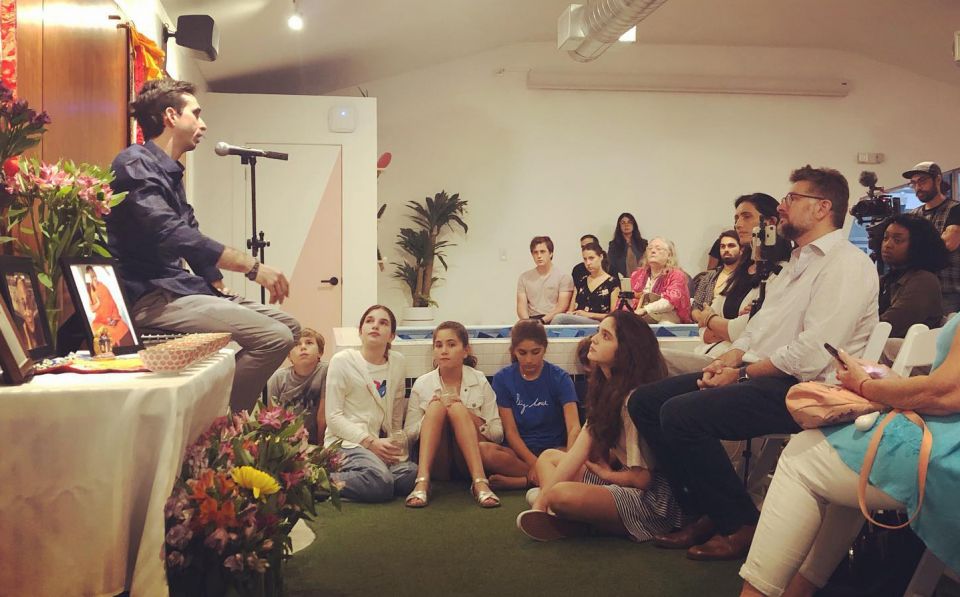
Tenzin Ösel Hita giving a talk at the Wotel, Miami, Florida, US, August 2019. Photo by Marcelo Paez.
On Thursday, August 15, 2019, Tenzin Ösel Hita gave an evening talk “A Taste of Buddhism: One Big Love” at the Wotel in Miami, Florida, US, hosted by the FPMT study group in Miami, Namdrol Ling Study Group. On Saturday, August 17, Ösel gave an afternoon talk “Inner Creativity: How to Overcome Attachment” at Thubten Kunga Ling Center, the FPMT center in Deerfield Beach, Florida. Maria Cersosimo, Namdrol Ling Study Group co-founder and coordinator, and Nicole Zito, Thubten Kunga Ling Center director, share the story.
We rejoice in the visit of Tenzin Ösel Hita to Miami! The event was a huge success with seventy-five people registered, a record for our little study group! The majority of the crowd were non-Buddhists, and the event took place in the totally secular environment of an advertising agency.
Ösel gave a very sincere, straightforward talk, covering Buddhist values, the importance of a daily meditation practice, and simple tips in order to lead a happier life. His sense of humor was present during the talk, and overall his joyful and humorous energy kept the crowd hooked, even the children in the audience. There were questions from the audience, including some from the kids, that he answered very truthfully and humbly.
As the co-founder and director of Namdrol Ling Study Group, this has been such a precious and memorable experience. I received many messages and thanks from the attendees, telling me how grateful they were for the opportunity to have met him. We hope Ösel can come back soon!
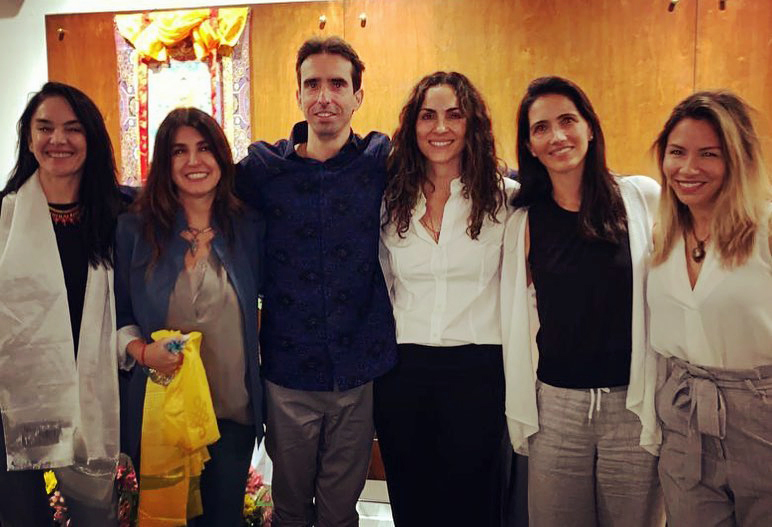
Tenzin Ösel Hita with volunteers Cynthia Zak, Alejandra Paez, co-founder and director Maria Cersosimo, co-founder Ana Paula Ruano, and volunteer Claudia Regazzio at the Wotel, Miami, Florida, US, August 2019. Photo by Marcelo Paez.
The auspicious visit to Thubten Kunga Ling by Tenzin Ösel Hita was surely one to remember and will go down in our center’s history. We were sold out and had reached our building’s maximum capacity within a few weeks of announcing this precious visit, and we had less than two months to prepare. We worked together to make this a most special day for the center and the community, and to honor the lives, service, kindness, and love of Lama Thubten Yeshe and Tenzin Ösel Hita.
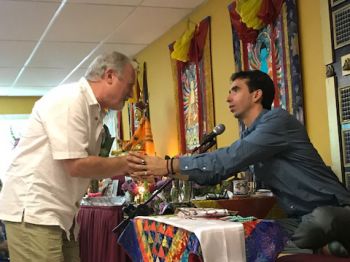
Tenzin Ösel Hita with Anthony Sherbondy at Thubten Kunga Ling Center, Deerfield Beach, Florida, US, August 2019. Photo by Carly Zito.
Teams of volunteers began mentally and physically preparing for the big event weeks ahead of time. We invited two Lynn University film students from nearby Boca Raton, Florida, to record the event. We are very grateful to Yaren and Brian for volunteering their time and efforts. Adrienne donated and arranged an abundance of flowers, and Sonny offered dinner to Ösel, both of which were lovely offerings of generosity and kindness.
Ven. Lhundub Tendron, the FPMT resident teacher at Thubten Kunga Ling, opened the August 17, 2019 event at 1 p.m. with a meditation on interdependence and emptiness. Ösel arrived at 2:30 p.m. and spoke for one-and-a-half hours on “Inner Creativity: How to Overcome Attachment.” He walked into a room packed with enthusiastic students, both old and new, of different backgrounds and ages, but with one thing in common: a very strong connection to Dharma and to him.

Tenzin Ösel Hita with George Propps at Thubten Kunga Ling Center, Deerfield Beach, Florida, US, August 2019. Photo by Nicole Zito.
Ösel shared about the insight and wisdom he has gained along his path. He spoke about his time spent in the monastery, how he puts the Dharma into practice in his daily life, and how his teachers continue to have a major influence in his life.
The talk was very light and humorous, and his words touched the hearts of everyone who attended this special event. The energy at the event was slightly euphoric. Many beings came together that afternoon as strangers and left as friends.
We had seventy-one guests, twenty-six volunteers, three board members, and five sponsored students attend the event. Many of our guests came from out-of-town: two students came from Washington, DC, two students came from North Carolina, three from the west coast of Florida, five from central Florida, and over ten students from Miami. A handful of these visitors were students of Lama Yeshe’s in the 1970s.

Tenzin Ösel Hita with Nicole Zito at Thubten Kunga Ling Center, Deerfield Beach, Florida, US, August 2019. Photo by Carly Zito.
We received such positive feedback from this event. Everyone said they were honored to meet Ösel, that they look forward to staying connected with him, hope he will return again, and wish him the best along his journey ahead. Students loved his humor, the way he addressed “spiritual bypass,” his way of sharing life’s lessons, and his Bob Marley and Bruce Lee quotes!
Ösel’s unique style—the way he shares his own experiences and wisdom to bridge the gap between the East and West—helped us connect with our own experiences. We were reminded that our own inner wisdom and disturbing emotions serve as a constant platform for introspection, reflection, and self-growth. Change is possible and is up to each individual person.
Watch Tenzin Ösel Hita’s talk at the Wotel:
https://youtu.be/qzc4DAz1IYw
Watch Tenzin Ösel Hita’s talk at Thubten Kunga Ling Center:
https://youtu.be/pjqXZnbHZXM
FPMT.org and Mandala Publications brings you news of Lama Zopa Rinpoche and of activities, teachings, and events fromover 160 FPMT centers, projects, and services around the globe. If you like what you read, consider becoming a Friend of FPMT, which supports our work.
- Tagged: maria cersosimo, namdrol ling study group, tenzin osel hita, thubten kunga center, ven. lundub tendron
7
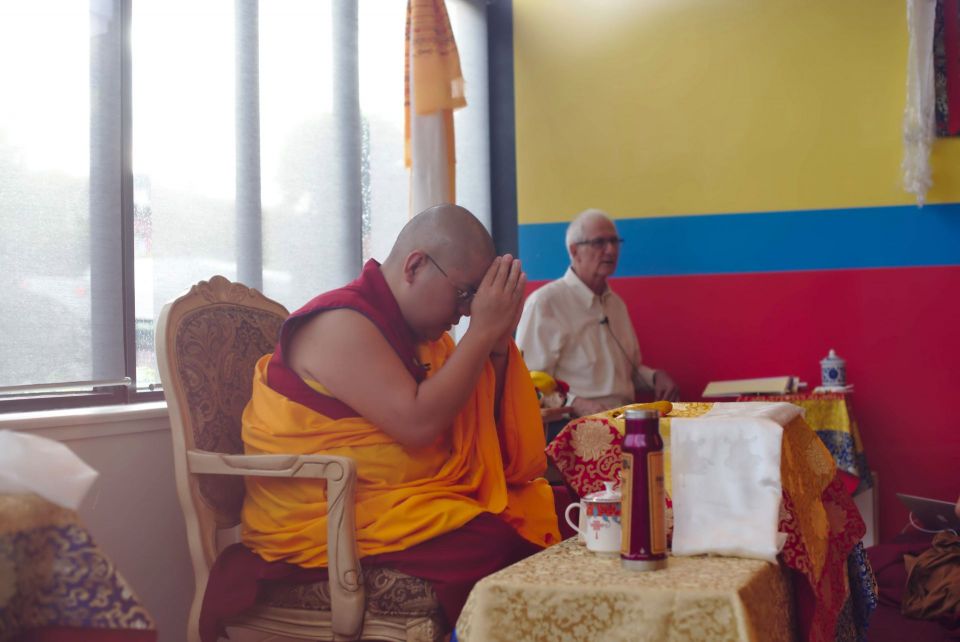
H.E. Ling Rinpoche at Shantideva Meditation Center, Brooklyn, New York, US, July 2019. Photo by Leonard J. Wilson.
His Eminence the 7th Kyabje Ling Rinpoche visited North America from June to August 2019 and engaged in many activities including teaching at US FPMT centers Shantideva Meditation Center in Brooklyn, New York, Milarepa Center in Barnet, Vermont, and Kurukulla Center in Medford, Massachusetts. On July 31 Rinpoche taught the Eight Verses of Mind Training at Shantideva Center, sponsored by Himalayan Elders Project; from August 9-10 Rinpoche taught “The Importance of Private Retreat in the Development of Your Dharma Practice” and “How to Develop Bodhicitta and Emptiness” at Milarepa Center; and from August 16-18 Rinpoche taught The Bodhisattva Jewel Garland by Atisha and gave the Amitayus Long Life Initiation at Kurukulla Center. Jennifer Kim, Shantideva Center board member, and Dawn Holtz, Milarepa Center director, share the story.
H.E. Ling Rinpoche taught on the Eight Verses of Mind Training at Shantideva Center as part of Rinpoche’s North American tour, which has been part of Rinpoche’s Sentient Being tour—visiting the world of us sentient beings who are trapped by the mental afflictions that create suffering situations for ourselves and others.
Like others who make world tours, Rinpoche is a bit of a rock star. Recognized as the reincarnation of the senior tutor of His Holiness the Dalai Lama, Rinpoche is well-known and the visit was much anticipated.
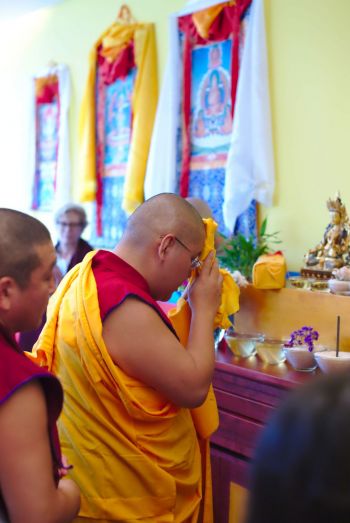
H.E. Ling Rinpoche at Shantideva Meditation Center, Brooklyn, New York, US, July 2019. Photo by Leonard J. Wilson.
Yet unlike a stereotypical rock star, Rinpoche highlighted the greatness of others instead of highlighting Rinpoche’s own. Rinpoche repeatedly emphasized the kindness of others. Without our mother caring for us in the womb and looking after us day and night, and without the unnoticed beings who provide our food, shelter, and necessities for survival, we could not be here today. The only reason we are here is because of the love and care from others. Sentient beings are also essential on our path to Buddhahood. Without them we could not practice the six perfections. For instance, if we give charity to others we usually consider ourselves the benefactor. But if looked another way they are our benefactors, giving us the opportunity to practice Dharma and benefit from it. If we are given harm by others we usually consider ourselves the victim. But if looked another way they test the strength of our own wisdom and our willingness to help.
Rinpoche also offered advice on how to subdue our own minds, the aim of Buddha’s teachings. Rinpoche warned us about the bias we often have for those within our social class, nationality, religion, or ethnicity. Rinpoche reminded us of our current state, fraught with uncertainty, as we might be in another existence before the sun rises tomorrow. Rinpoche also shared advice for how to respond to the habitual delusions that arise in our minds, especially when we are provoked by others who remind us of our karmic role in a situation and blindly create suffering for themselves in the future.
While sharing this wisdom of the eleventh-century master Geshe Langri Tangpa, Rinpoche said that these eight verses are easy to read but difficult to practice. Rinpoche also provided an oral transmission of the verses and suggested that we should take them up as our main practice to subdue our minds. Our bodhisattva rock star has shared the song, and now it’s up to us to practice the tune. With gratitude, we hope to create harmony with our practice and create the causes to see Rinpoche again soon.
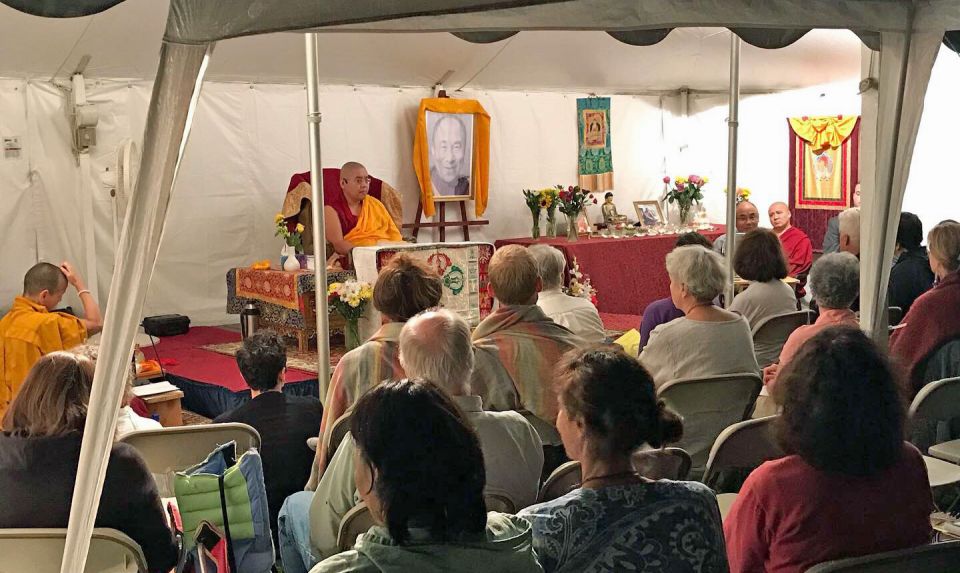
H.E. Ling Rinpoche teaching at Milarepa Center, Barnet, Vermont, US, August 2019. Photo by Dawn Holtz.
Milarepa Center was incredibly fortunate to host His Eminence the 7th Kyabje Yongzin Ling Rinpoche on August 8-10, 2019. Rinpoche arrived on the afternoon of Thursday, August 8, and departed after lunch on Saturday, August 10.
With its beautiful and serene private landscape, Milarepa Center was able to offer Rinpoche and attendants Ven. Tenzin Khentse and Geshe Lobsang Yonten a retreat atmosphere during their stay. Rinpoche, Ven. Tenzin Khentse, and Geshe Lobsang Yonten enjoyed walks on the beautiful land and surrounding areas, and a sailing trip on a local lake.
As a very small and simple center hosting such a highly realized and amazing being was far more than we could have ever imagined. Months and months of planning were involved, especially since we are in a rural area that does not have access to a lot.
Almost immediately upon Rinpoche’s arrival we could feel the blessings raining down, and the energy in the air was electrifying. It was a very special time for us. There were no teachings scheduled for the first evening of Rinpoche’s arrival, so we were able to enjoy some very special and private time with Rinpoche, just relaxing and talking in the dining room. Rinpoche and I even traded eyeglasses to see who had the stronger prescription (we were pretty even!), and Rinpoche joked with me that my glasses “look ancient, like from a museum!” Many many laughs were shared during the visit; we were so incredibly fortunate.
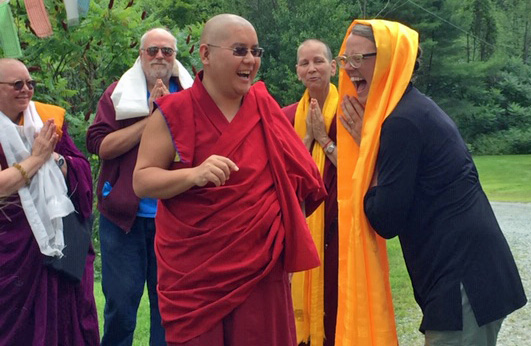
H.E. Ling Rinpoche and Dawn Holtz at Milarepa Center, Barnet, Vermont, US, August 2019. Photo by Meri Stiles.
Rinpoche gave the first teaching at 7 p.m. on Friday evening titled “The Importance of Private Retreat in the Development of Your Dharma Practice.” This teaching was requested to coincide with advice given from Lama Zopa Rinpoche in 2017 for Milarepa Center to focus on offering students a private solitary retreat facility. With Lama Zopa Rinpoche’s advice currently being at the forefront of our operations, we made a request that His Eminence Ling Rinpoche offer a teaching on the importance of private retreat in developing one’s Dharma practice.
During that particular teaching Rinpoche spoke about the extreme importance of study, and also having a conducive environment in which to engage in both practice and study. Rinpoche also spoke about how the environment here at Milarepa Center is very very good for this and that there are many very happy nagas present here, which is why our land is so beautiful and feels so incredibly prefect for retreat.
The Saturday morning teaching that Rinpoche gave was titled “How to Develop Bodhichitta and Emptiness.” The program was attended by a mix of lay and ordained students from both near and far, including local Tibetans from the Burlington, Vermont, area as well as a few local Sherpa families. Both talks were very well attended.
For more information about H.E. Ling Rinpoche’s schedule, visit Rinpoche’s website:
http://lingrinpoche.info/
For more information about Shantideva Meditation Center, visit their website:
https://shantidevanyc.org/
For more information about Milarepa Center, visit their website:
http://milarepacenter.org/
FPMT.org and Mandala Publications brings you news of Lama Zopa Rinpoche and of activities, teachings, and events from over 160 FPMT centers, projects, and services around the globe. If you like what you read, consider becoming a Friend of FPMT, which supports our work.
- Tagged: dawn holtz, jennifer kim, kyabje ling rinpoche, milarepa center, shantideva meditation center
4

Spring Retreat with Geshe Thubten Rabten at Atisha Centre, Myers Flat, Victoria, September 2019. Photo by Andy Melnic.
In 2019, Atisha Centre, an FPMT center in Myers Flat, Victoria, Australia, offered their annual Spring Retreat with Geshe Thubten Rabten, the center’s FPMT resident geshe, from September 12-17. The theme of this year’s retreat was In Praise of Dependent Arising by Lama Tsongkhapa. Andy Melnic, spiritual program coordinator, shares the story.
The Spring Retreat was excellent! About twenty-five people attended altogether. Geshe Thubten Rabten taught each of the five days, giving a commentary on Lama Tsongkhapa’s In Praise of Dependent Arising.
Gen-la has been teaching this subject for most of this year as the main topic of our fortnightly Study Group. He completed that course in August. The repetition of In Praise of Dependent Arising, this time taught in a condensed form over five days, was a great recap for those who attended this year’s Study Group. For other attendees this retreat was a fantastic introduction to the subject of dependent arising.
Gen-la presented the heart of the subject while also incorporating the entire lamrim teachings into his commentary. He is a very skillful teacher.
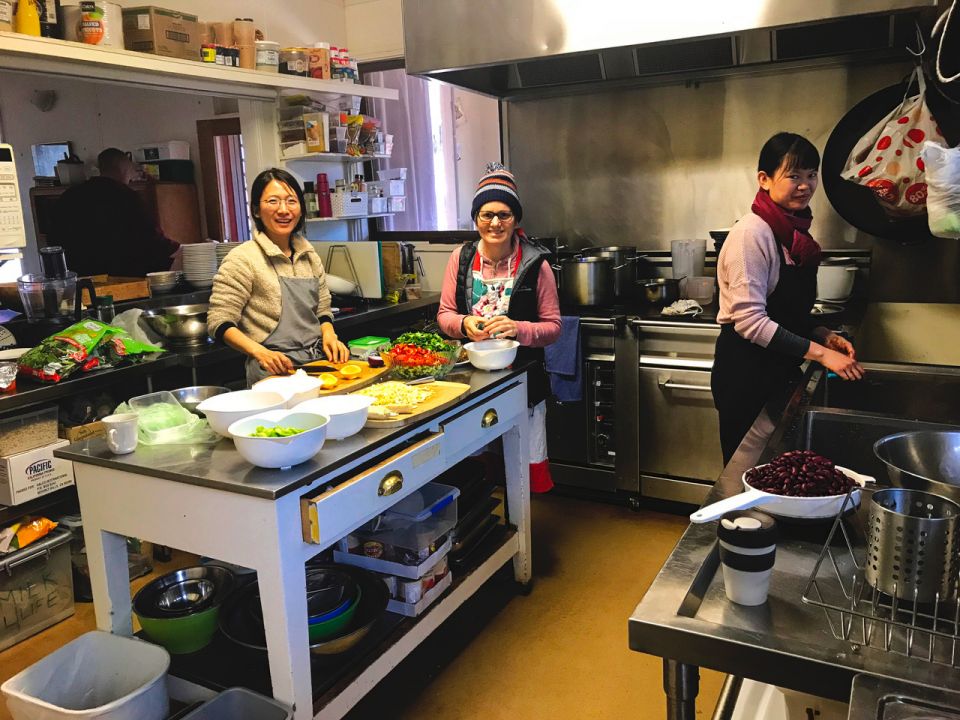
Minji, Katy, and Pei preparing a meal in the Atisha Centre kitchen, Myers Flat, Victoria, September 2019. Photo by Andy Melnic.
The daily meditation and discussion sessions were facilitated by the energetic Ven. Jampa Choepal, a resident of nearby Thubten Shedrup Ling Monastery and prayers were led by Ven. Tenzin Tsapel, who is establishing a nunnery nearby.
Everyone had a great retreat and the feedback was glowing! Our great cook, Katy, and her catering team surpassed themselves. The weather was great, and the food was healthy and delicious. The karma was just right!
For more information about Atisha Centre, visit their website:
https://atishacentre.org.au/
FPMT.org and Mandala Publications brings you news of Lama Zopa Rinpoche and of activities, teachings, and events from over 160 FPMT centers, projects, and services around the globe. If you like what you read, consider becoming a Friend of FPMT, which supports our work.
29
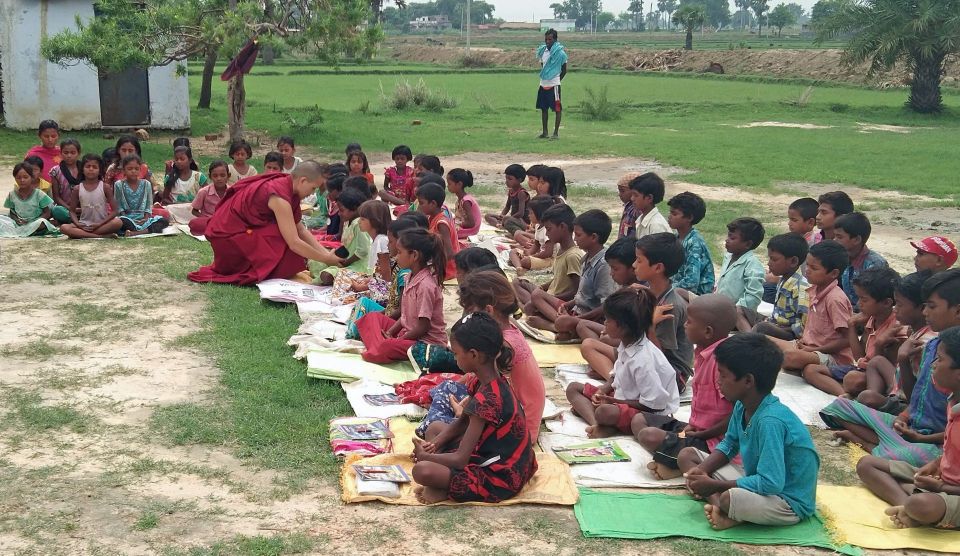
Ven. Anshu Negi with Class 1 students at Fulchater School, Fulchater Village, Gaya District, Bihar, India, July 2019. Photo courtesy of MAITRI Charitable Trust.
In July 2019, FPMT project MAITRI Charitable Trust in Bodhgaya, Gaya District, Bihar, India, made a new offering of Dharma education at MAITRI Fulchater School. Since 1999, MAITRI and Fulchater Village in Bihar have been working together to operate a thriving primary school. Also in July, MAITRI celebrated the thirtieth anniversary of its Leprosy Prevention, Treatment, and Rehabilitation Centre, which was the only organization authorized by the government of Bihar to run the National Leprosy Eradication Program in three provinces of Gaya District from 1989 to 2002. Since then MAITRI has been collaborating with Bihar State Health Services. MAITRI’s director, Adriana Ferranti, shares the story of these activities.
On Lama Zopa Rinpoche’s request, MAITRI started a program of Dharma education at Fulchater School. On July 12, Ven. Anshu Negi, a classroom teacher at Maitreya School, a project of Root Institute for Wisdom Culture, offered preliminary breathing and meditation exercises at Fulchater School. Since Ven. Anshu visited Fulchater School in the morning, only the younger children were at the school. The following Friday, Ven. Anshu went for the afternoon shift, so she was able to benefit the older children.
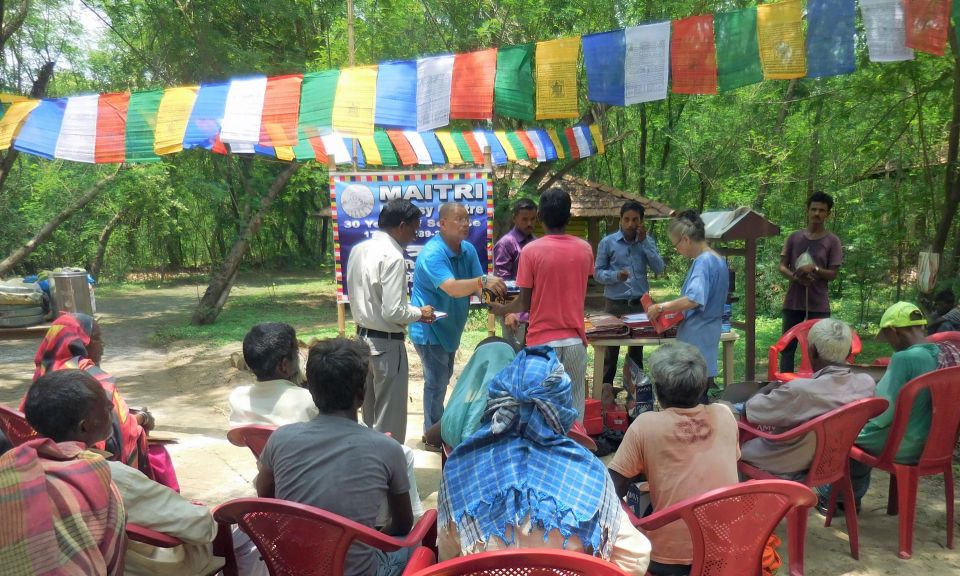
Kiran Lama offering clothes and sandals at MAITRI Charitable Trust, Bodhgaya, Gaya District, Bihar, India, July 2019. Photo courtesy of MAITRI Charitable Trust.
Thirty years ago, on July 17, 1989, MAITRI Leprosy Centre began offering service in the province of Bodhgaya. On July 17, 2019, we called some long-time and newer patients together to commemorate that day. It was a simple and unpretentious event at MAITRI graced by the presence of our friend and trustee, Mr. Kiran Lama. We shared some food and offered clothes and special sandals. It made it all so worthwhile.
For more information about MAITRI Charitable Trust, visit their website:
http://www.maitri-bodhgaya.org/home/
For the seventh year, due to the kindness of a benefactor, the FPMT Social Services Fund has been offering substantial grants to MAITRI in support of their incredible and compassionate work and service.
FPMT.org and Mandala Publications brings you news of Lama Zopa Rinpoche and of activities, teachings, and events from over 160 FPMT centers, projects, and services around the globe. If you like what you read, consider becoming a Friend of FPMT, which supports our work.
19
Tenzin Osel Hita’s Recent and Upcoming Dharma Talks
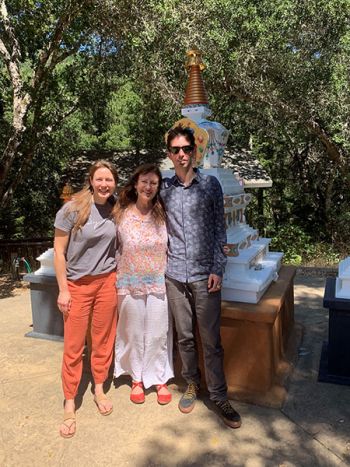
Director of Vajrapani Institute Heidi Oehler, Director of Tara Redwoods School Pam Cayton, and Osel at Lama Yeshe’s cremation Stupa at Vajrapani Institute. August 4, 2019. Photo by Jacie Keeley.
This summer Tenzin Osel Hita (the recognized incarnation of Lama Yeshe) gave a number of Dharma talks in FPMT centers and study groups in the United States. Starting in August Osel visited and spoke at Vajrapani Institute, Land of Medicine Buddha, Gyalwa Gyatso, and Tse Chen Ling, in California; and then traveled to Florida where he spent time at Namdrol Ling, in Miami, and Thubten Kunga Ling, in Deerfield Beach.
Osel Hita has long had the ambition to create intentional ecovillage communities fostering a sustainable lifestyle where community living is valued and practiced.
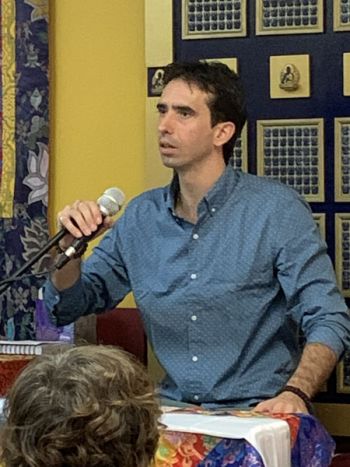
Osel speaking at Thubten Kunga Ling in Deerfield Beach, Florida. Photo by Jacie Keeley.
Land of Medicine Buddha, which has established itself as an environmentally conscious meditation and retreat center, was chosen as the host site for Osel to pilot some of his signature concepts in August. A four-day event (August 4-7) that Osel called “Being Your True Nature: A Being Experience and Habit Alignment” was a balance of personal reflection and renewal through connection with nature, meditation, Dharma talks, body movement, and healthy eating. Each participant was encouraged to connect with their true nature and innate wisdom in order to be of greater benefit to the whole world, or what Osel calls “collective consciousness.”
Osel was able to connect to hundreds of students while on this tour in the United States, and reports from those in attendance shared a common theme of transformation and elevated energy.
Osel is offering the following talks in England:
- November 28, 7pm-9pm: “Creating a Better Future” at Jamyang Buddhist Centre, London, England.
- December 1, 2pm-4pm: “A Chat with our Virtuous Friend” at Land of Joy, Northumberland, England.
- December 4, 6:30pm-4pm: “We are Bigger than our Problems” at Jamyang Buddhist Centre Leeds, Leeds, England
Please enjoy this public talk Osel gave at Gyalwa Gyatso in August:
The Big Love Fund was established to provide financial resources to support the educational endeavors of Osel. All are welcome to contribute any amount to this fund.
- Tagged: osel, osel hita, tenzin osel hita
15
We Hope You Enjoy Our November e-News
Welcome to our November FPMT International Office e-News!
This month you’ll find news about:
- Lama Zopa Rinpoche’s Advice for Honouring Lama Tsongkhapa
- Featured Materials from FPMT Education Services
- 1,000 Statues for His Holiness Sponsored
- Fruitful FPMT Service Development
…and more!
Have the e-News translated into your native language by using our convenient translation facility located on the right-hand side of the page.
The FPMT International Office e-News comes from your FPMT International Office. Visit our subscribe page to receive the FPMT International Office News directly in your email box.
13
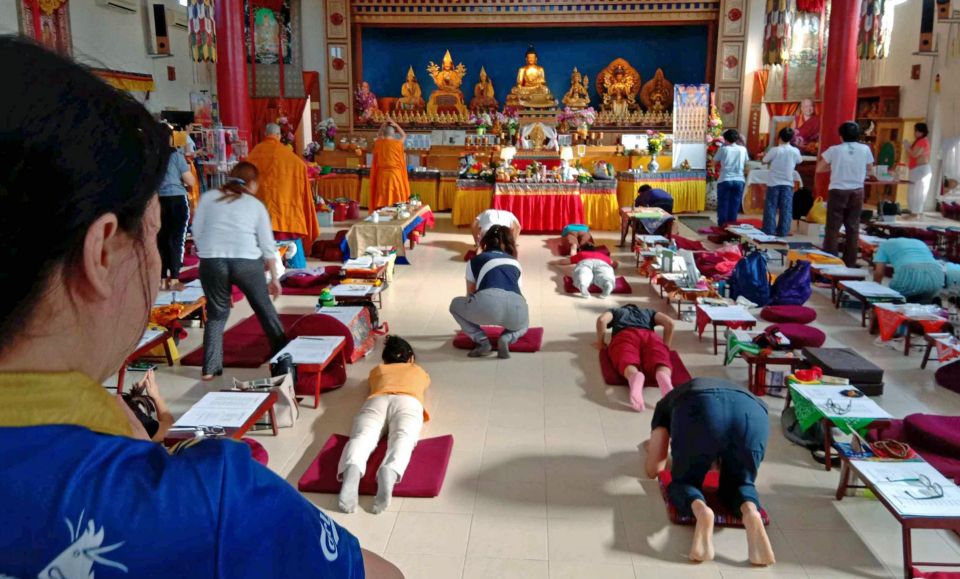
Nyung Nä Retreat at Rinchen Jangsem Ling Retreat Centre, Triang, Malaysia, July 2019. Photo courtesy of Rinchen Jangsem Ling.
In 2019 Rinchen Jangsem Ling Retreat Centre, the FPMT center in Triang, Malaysia, celebrated the month of Saka Dawa (June 4-July 2, 2019) by offering a Kuan Yin Retreat. (Kuan Yin is also known by the Sanskrit name Avalokitesvara and the Tibetan name Chenrezig.) The Kuan Yin Retreat was composed of two programs: a mani mantra retreat from June 16-July 14, and a nyung nä retreat from July 20-21. The mani mantra retreat is an annual event that began in 2008. Ven. Sonam Yeshe, center director, shares the story about the Kuan Yin Retreat.
Every year Rinchen Jangsem Ling conducts a mani mantra retreat around the holy month of Saka Dawa so people can participate in the recitation of the mani mantra (OM MANI PADME HUM) and create a connection with the Buddhadharma. The retreat was conceptualized twelve years ago to engage as many people as possible in the recitation of OM MANI PADME HUM through joining weekend group recitations (including a Dharma talk) or performing the retreat in one’s own home. The latter is essential as Rinchen Jangsem Ling is in a rural area surrounded by palm oil and rubber trees, three miles (five kilometers) from Triang, the nearest small town, and it’s difficult to gather people to attend Rinchen Jangsem Ling’s regular program.
The mani mantra retreat is designed to be as simple as possible for everyday folks who might not be connected to Rinchen Jangsem Ling or even Tibetan Buddhism at all. OM MANI PADME HUM is a very easy mantra, and it is a Kuan Yin practice which many people enjoy. During the retreat I encourage participants to recite the mantra based on a lamrim motivation and with the motivation to benefit others. Many participants recite the mantra for their loved ones who are sick, have numerous personal problems, or for the benefit of their gurus and sentient beings. We encourage participants to make a motivation to benefit others by giving participants the opportunity to have a name inscribed on a plaque for every 110,000 mantras recited.
On average we have more than 250 participants from across Malaysia and overseas (Mexico, UK, Australia) participating in the mani mantra retreat every year. An average of thirty million mani mantras are recited every year.
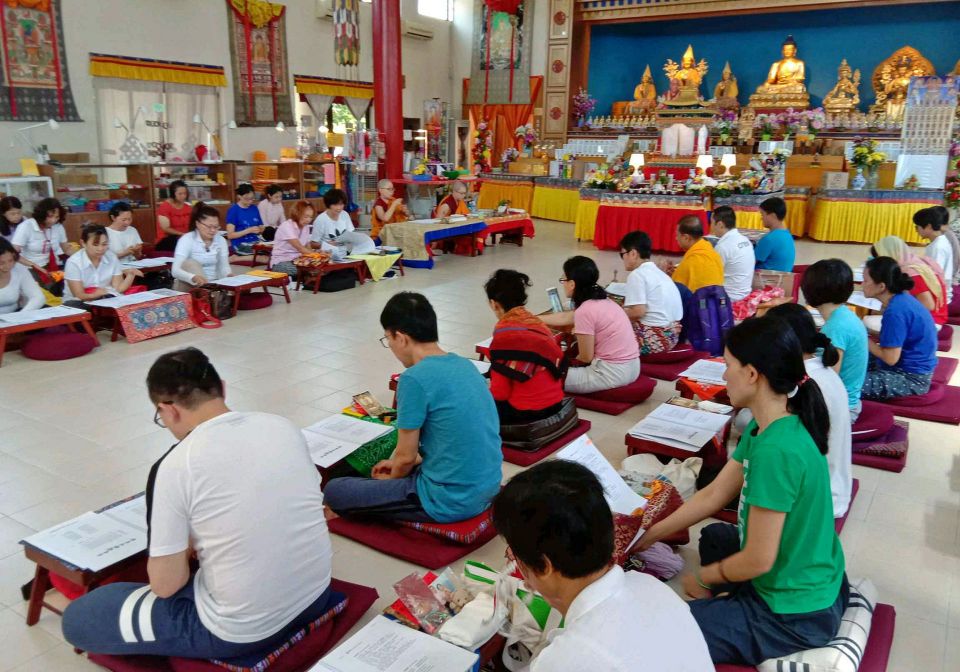
Nyung Nä Retreat at Rinchen Jangsem Ling Retreat Centre, Triang, Malaysia, July 2019. Photo courtesy of Rinchen Jangsem Ling.
Rinchen Jangsem Ling also conducts a nyung nä retreat during the holy month of Saka Dawa.
In the past the nyung nä retreat was conducted in English and led by our present FPMT Southeast Asia regional coordinator Selina Foong. But due to the need to reach out to a wider Buddhist audience, which is a majority Chinese-speaking community, Rinchen Jangsem Ling held its first nyung nä retreat in Chinese (Mandarin) last year led by Malaysian nun Ven. Thubten Dechen.
Traditionally, any practices related to Kuan Yin (Chenrezig) resonate exceptionally well within the Chinese community and in particular the Chinese Mahayanist community. The practice of nyung nä is no exception.
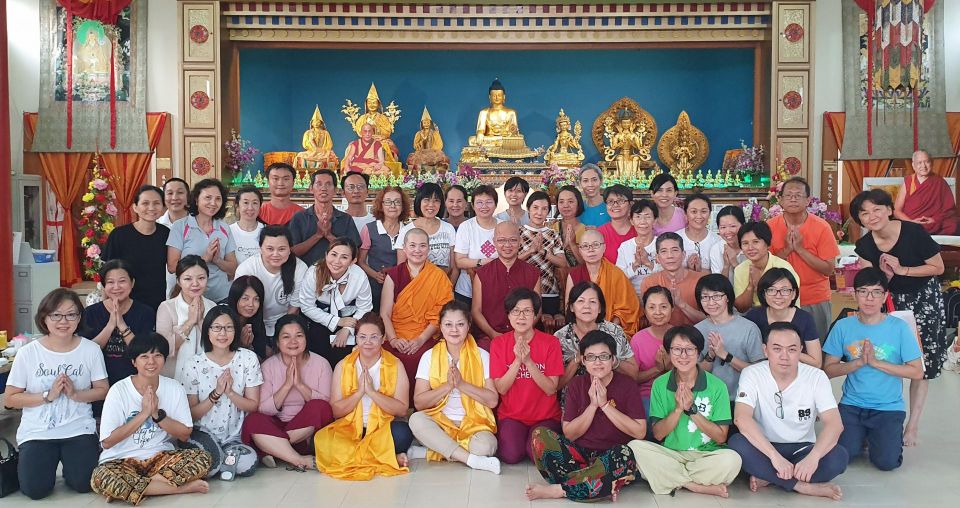
Nyung Nä Retreat at Rinchen Jangsem Ling Retreat Centre, Triang, Malaysia, July 2019. Photo courtesy of Rinchen Jangsem Ling.
The nyung nä retreat became an instant hit, so much so that fifty-four people participated in this year’s retreat. Many of the participants were not only new to the nyung nä practice but were also new to Tibetan Buddhism. Nevertheless, many participants attended with great faith due to it being the Kuan Yin Retreat. We are all very much encouraged by this and hope to continue with this tradition every year at Rinchen Jangsem Ling.
Watch a video of the Nyung Nä Retreat on YouTube:
https://youtu.be/HCtym7uSaTY
We would like to extend our sincere gratitude and appreciation to Ven. Thubten Dechen, Rinchen Jangsem Ling staff, volunteers, and other Sangha members who led the prayers. We would also like to thank all those in attendance, especially our many many Dharma brothers and sisters from the FPMT center in Selangor, Malaysia, Losang Dragpa Centre, especially their director and staff who have been giving us all kinds of assistance. Due to the Guru’s unfathomable kindness and teachings, may we dedicate every merit created to the fruition of full enlightenment and to all FPMT centers so that we can most quickly and fully benefit all beings.
For more information about Rinchen Jangsem Ling Center, visit their website:
http://www.jangsemling.com/
FPMT.org and Mandala Publications brings you news of Lama Zopa Rinpoche and of activities, teachings, and events from over 160 FPMT centers, projects, and services around the globe. If you like what you read, consider becoming a Friend of FPMT, which supports our work.
- Tagged: mani mantra, nyung nä, rinchen jangsem ling, selina foong, ven. sonam yeshe, ven. thubten dechen
6
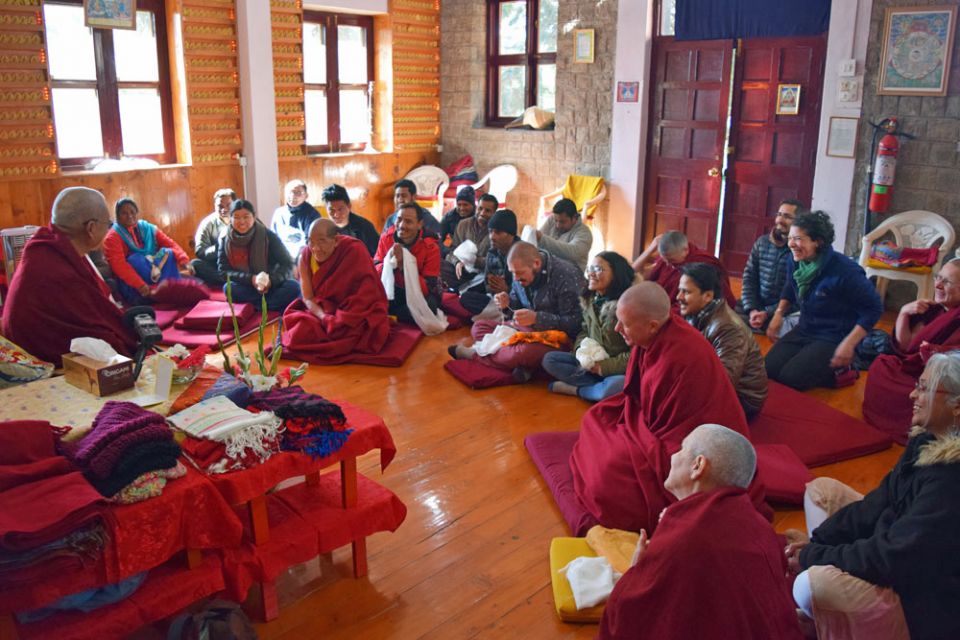
Lama Zopa Rinpoche and Tushita Meditation Centre staff at Tushita Meditation Centre, Dharamsala, Himachal Pradesh, India, February 2019. Photo by Tushita Meditation Centre.
Tushita Meditation Centre, the FPMT center in Dharamsala, Himachal Pradesh, India, enjoyed visits from Lama Zopa Rinpoche and Khyongla Rato Rinpoche in 2019. Ven. Tenzin Kunphen, spiritual program coordinator, and Maria Nobuko Corrales, creative project assistant, share those stories and more.
Our 2019 season started extra early on February 5 to coincide with the Tibetan New Year and the auspicious Days of Miracles. The weather at that time of year can make things difficult in Dharamsala, but we made the best of some serious snowstorms and power cuts and didn’t have to wait long for the miracles to happen. To our great delight we welcomed our Spiritual Director Kyabje Lama Zopa Rinpoche for ten days later in February.
We also welcomed all the students who braved the middle of winter at Tushita to attend our first Introduction to Buddhism course of 2019. One of those students was Abdulwahab, who was our first student from Kuwait. Abdulwahab’s presence made Kuwait the 100th nation represented by students attending our residential courses. In July, we welcomed Douangluethay from Laos, our 101st nation. And in August, we welcomed Dolly from Kenya, our 102nd nation.
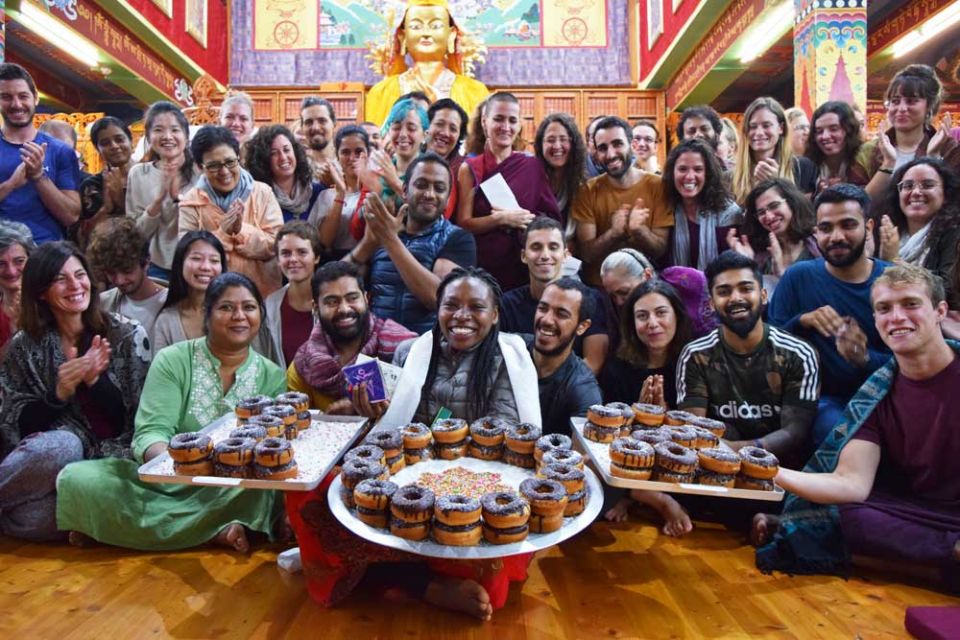
Dolly and fellow Introduction to Buddhism retreat students at Tushita Meditation Centre, Dharamsala, Himachal Pradesh, India, August 2019. Photo by Tushita Meditation Centre.
We are so excited to have reached this momentous accomplishment and rejoice deeply in what it represents: the Dharma reaching the far corners of the planet. We are now aiming to reach the auspicious number of 108 nations at Tushita since we began keeping records ten years ago.
Lama Zopa Rinpoche arrived at Tushita after midnight on February 18, the last day of the first introductory course of the year. Beautiful snowflakes began to fall as Rinpoche greeted the shivering and excited crowd, seemingly blessing the land and the fortunate students who waited in the dark to warmly welcome Rinpoche.
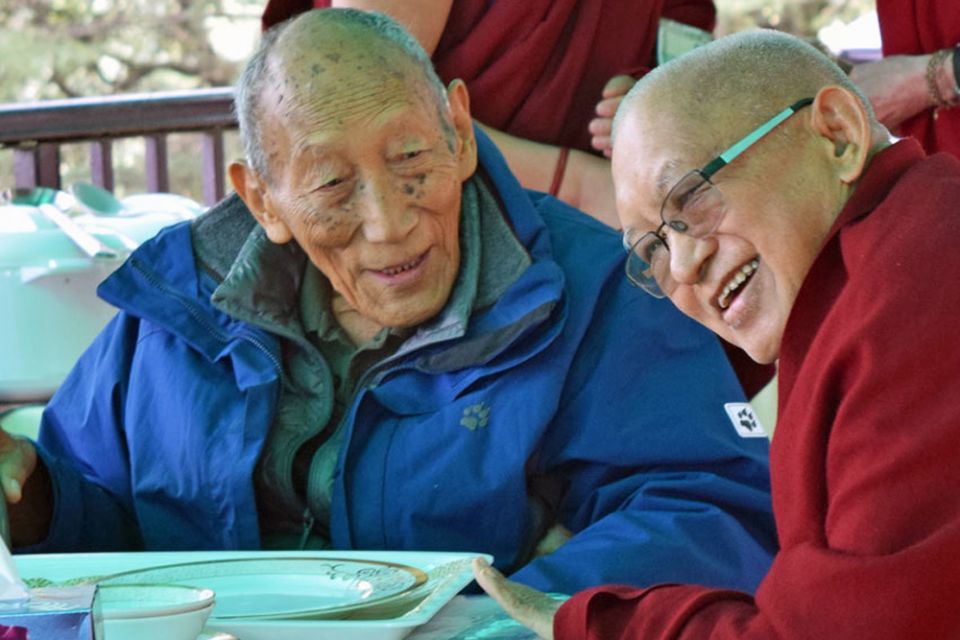
Khyongla Rato Rinpoche and Lama Zopa Rinpoche at Tushita Meditation Centre, Dharamsala, Himachal Pradesh, India, February 2019. Photo by Tushita Meditation Centre staff.
On February 25, Lama Zopa Rinpoche offered a long life puja for Khyongla Rato Rinpoche at Tushita. This was an incredibly special day in which we welcomed many lamas, geshes, and Sangha. We pray that Khyongla Rato Rinpoche and all our precious gurus have long and stable lives, connecting many hearts and minds with the Dharma. May all their holy wishes be fulfilled instantly.
Still dazzled by so many blessings, we started another introductory course and an intermediate course two days later. Straight after their arrival, these lucky students (joined by the participants of our Pre-Ordination Course and many visitors) were extremely fortunate to receive two afternoons of precious teachings from Lama Zopa Rinpoche on emptiness and guru devotion.
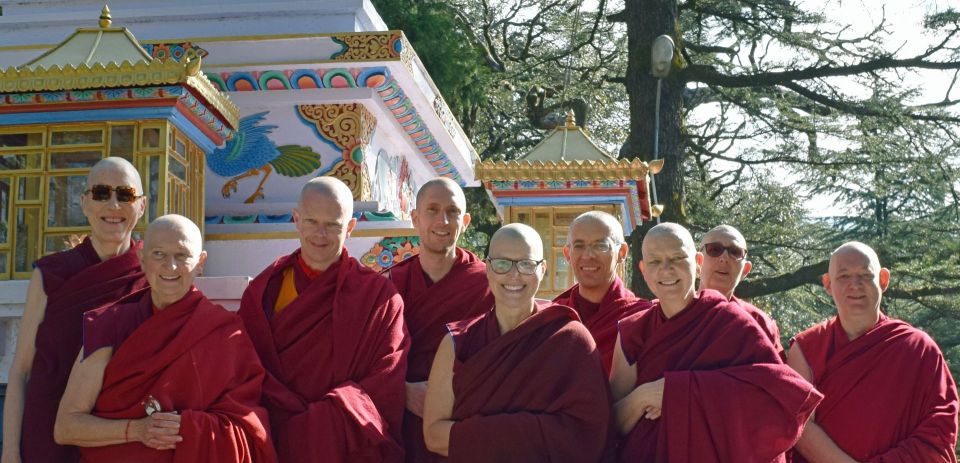
Geshe Tenzin Namdak returned to again lead the Pre-Ordination Course in support of eight new western Sangha members, Tushita Meditation Centre, Dharamsala, Himachal Pradesh, India, February 2019. Photo by Tushita Meditation Centre staff.
Rinpoche even made time to meet with and give a teaching to all Tushita staff and volunteers before leaving Tushita on the morning of February 28, showing us how to use every moment to benefit sentient beings. May we become just like you, Rinpoche.
Tushita Receives Consecrated Vases Blessed by His Holiness the Dalai Lama
There are many natural disasters happening all over the world today due to environmental destruction. In order to protect life and stop these natural disasters from occurring, His Holiness the Dalai Lama advised that consecrated vases be distributed wherever needed. Representatives from His Holiness’s private office, Namgyal Monastery, Gyudmed Monastery, and Gyuto Monastery came together to consecrate these vases over seven days.
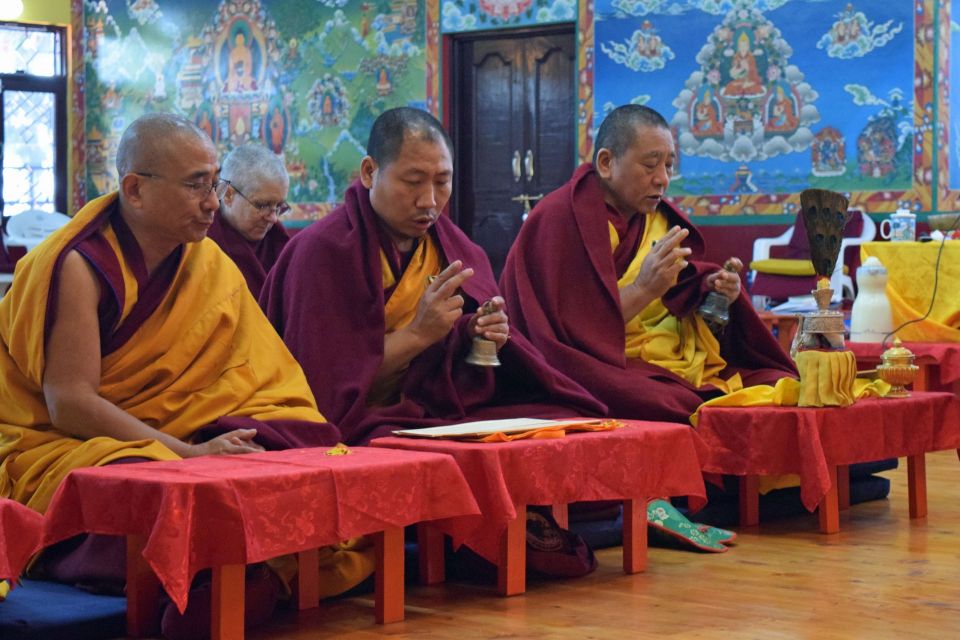
Puja at Tushita Meditation Centre, Dharamsala, Himachal Pradesh, India, March 2019. Photo by Tushita Meditation Centre staff.
Tushita was kindly offered three vases. To our great surprise and delight, on March 4 ,the abbot of Gyudmed Monastery, Khen Rinpoche Geshe Lobsang Wangdu, and a few monks from Namgyal Monastery came to conduct a puja to place these vases here at Tushita on our main altar.
Blessed by His Holiness, these vases serve to protect those who come here from obstacles, sickness, natural disasters, and harm from other beings. It also serves as a blessing to receive timely rain and water. Wherever the vase is placed there will be prosperity and flourishing without any obstacles.
Khylonga Rato Rinpoche Teaches on Bodhichitta
Khyongla Rato Rinpoche, despite his busy schedule and advanced age, very kindly returned to Tushita on April 7 before leaving for his home in the US. Rinpoche gave teachings titled “Bodhichitta: The Mind of Enlightenment” with his long-time student Simon Houlton interpreting.
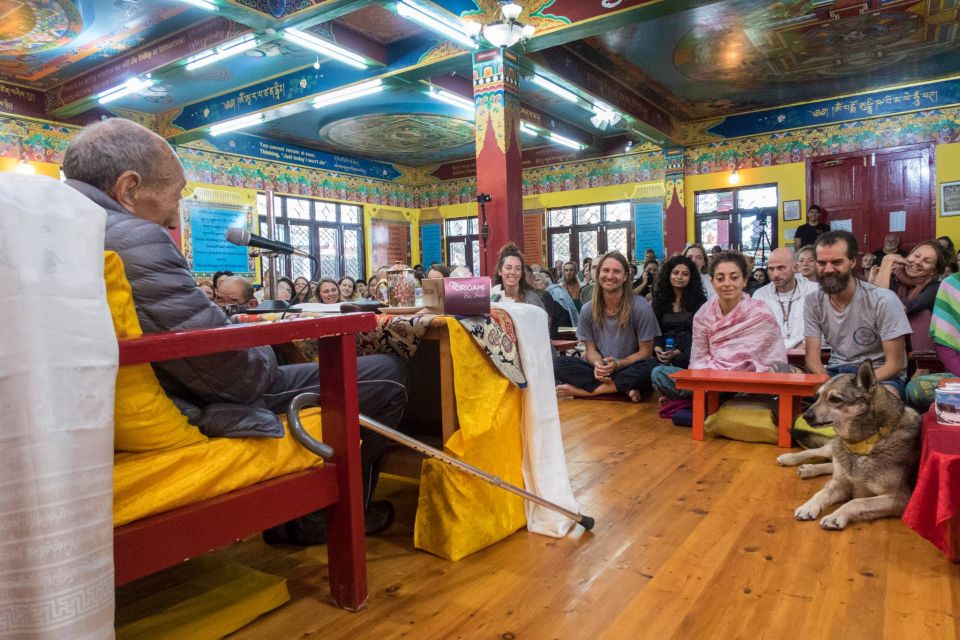
Khyongla Rato Rinpoche, students, and Nyingje Chenmo at Tushita Meditation Centre, Dharamsala, Himachal Pradesh, India, April 2019. Photo by Tushita Meditation Centre staff.
This special event was attended by our 130 residential students from our introductory course and intermediate course on “Developing a Fearless Heart” as well as outside guests. All present were hugely inspired by Rinpoche’s bodhisattva-like qualities of a brave heart, deep humility, and quick humor. How fortunate we are to have these real life examples of amazing practitioners around to show us where the Dharma path is leading and that it’s really possible.
Towards the end of the event our Tushita canine matron Nyinje Chenmo snuck into the gompa to listen to the teachings. She circumambulated His Holiness’s throne as well as Rinpoche and enjoyed the attention of the amused audience before laying down right in front of Rinpoche. Rinpoche looked at her and, to our great surprise and delight, spoke of Nyinje Chenmo having a calm mind and being so fortunate to live at Tushita and see so many holy objects.
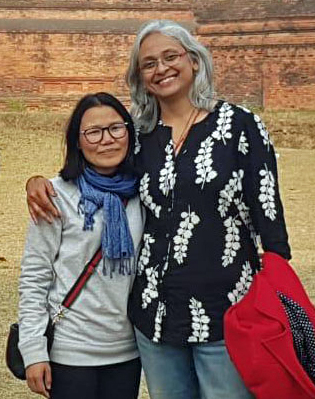
Pema Wangmo and Archhana Kombrabail at Nalanda, Bihar, India. Photo courtesy of Tushita Meditation Centre.
Tushita Welcomes Our First Female Tibetan Director
Early in the season we said farewell to acting director Archhana Kombrabail, who has served Tushita for the last two-and-a-half years in this role. We are grateful for all the energy, positive intentions, and beneficial actions she took on behalf of Tushita and all the students. Thank you so much, Archhana!
We are happy to welcome Pema Wangmo into the director role. Pema first joined Tushita in February 2017 as our friendly and ever-so-patient receptionist. With her particular skills and temperament Pema naturally transitioned to the role of center manager in mid-2018 before being appointed by Lama Zopa Rinpoche as director. We are so grateful for Pema’s dedication, hard work, and the kind heart she brings to the position.

Yeshe at Tushita Meditation Centre, Dharamsala, Himachal Pradesh, India, October 2017. Photo by Tushita Meditation Centre staff.
Our Beloved Dog Yeshe
It is with a heavy heart that we relay the passing of our beloved dog Yeshe on May 22. Our canine friends fulfill a very important job description at Tushita. Yeshe was our ever-so-patient therapist with excellent listening skills for our students as they undertook their difficult inner work and also a loyal companion and best friend, delighting and supporting our staff and volunteers by keeping their blood pressure steady and taking them for regular walks.
Yeshe’s life is a lesson of love: she showed us all how we are interconnected and that we need each other for our survival and happiness, that throughout our lives we must support and benefit each other daily, and that we can practice generosity by accepting the help of others.
We miss you, dearest friend and loyal companion. But we are confident that thanks to Lama Zopa Rinpoche’s and so many people’s prayers you smoothly made the transition from Tushita to the real Pure Land.
This story was extracted from “Tushita’s News July 2019”, available on Tushita’s website:
http://tushita.info/news/news-july-2019/
For information about Tushita Meditation Centre, visit their website:
http://tushita.info
FPMT.org and Mandala Publications brings you news of Lama Zopa Rinpoche and of activities, teachings, and events from over 160 FPMT centers, projects, and services around the globe. If you like what you read, consider becoming a Friend of FPMT, which supports our work.
- Tagged: archhana kombrabail, geshe tenzin namdak, his holiness the dalai lama, khyongla rato rinpoche, lama zopa rinpoche, maria nobuko corrales, pema wangmo, tushita meditation centre, ven. tenzin kunphen
1
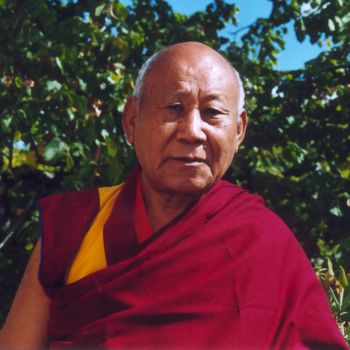
Geshe Losang Tengye. Photo courtesy of Institut Vajra Yogini.
Geshe Losang Tengye, who played an important role in helping establish Tibetan Buddhism in the West, stopped breathing in his room at Institut Vajra Yogini in France on Friday, October 19. Geshe Tengye stayed in clear light meditation for five days. He was 92.
Geshe Tengye was born in Lhatse, Tibet, in 1927. He went to the local monastery at the age of six. He followed a traditional path of in-depth monastic Buddhist study until the 1959 Chinese takeover of Tibet. He went into exile in India and continued his geshe studies at Buxa Chogar, the camp for refugee monks in Buxa Duar, West Bengal, India. Despite illness and hardship, Geshe Tengye received the lharampa geshe degree in 1969.
In 1980, at the request of FPMT co-founder Lama Thubten Yeshe, Geshe Tengye became the resident teacher at Institut Vajra Yogini (IVY), the newly established FPMT center located in the south of France near Toulouse. Due to Geshe Tengye’s infinite patience, wisdom, and compassion, IVY has grown into a large and flourishing Dharma center. He was much loved by his students and will be deeply missed.

Sangha and lay students doing prayers and practices for Geshe Tengye, Institut Vajra Yogini, France, October 2019. Photo courtesy of Institut Vajra Yogini.
Yangsi Rinpoche, who was a close student of Geshe Tengye, arrived at IVY from the United States on Saturday, October 21. He joined with Geshe Tenzin Loden, the current resident geshe at IVY, and Geshe Losang Jamphel and Geshe Jamphel Gyaltsen, the resident geshes at the nearby Nalanda Monastery, doing daily pujas as advised by Ganden Tripa Lobsang Tenzin Rinpoche, who was a close friend of Geshe Tengye. Western Sangha and lay students also did daily prayers and practices for Geshe Tengye. On Monday, October 28, the body of Geshe Tengye was taken to a local crematorium for cremation. IVY students will continue to do prayers and practices for Geshe Tengye through the forty-nine days, which ends on December 5.
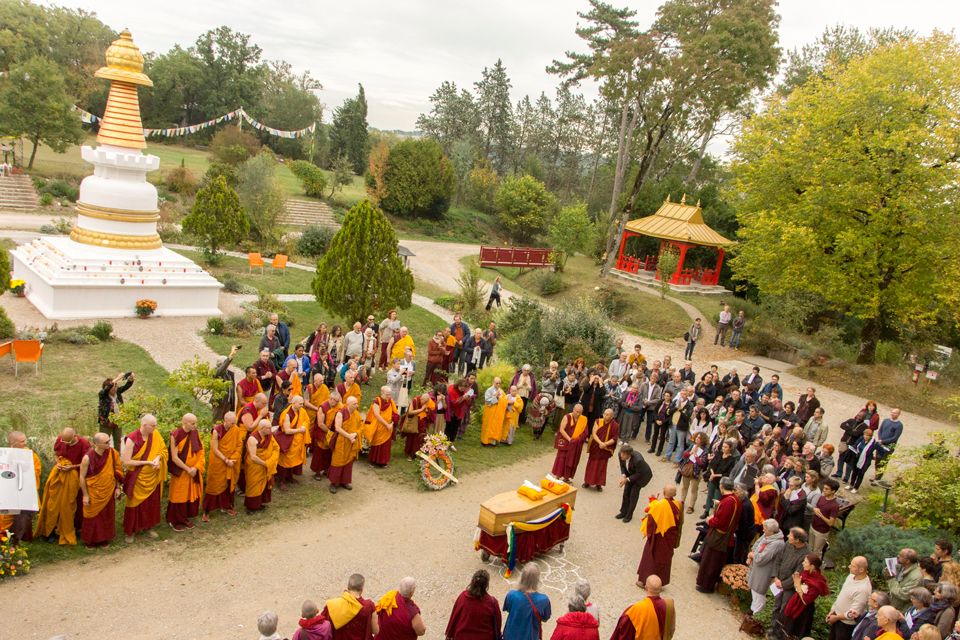
Sangha and lay students gathered for Geshe Tengye at Institut Vajra Yogini, France, October 2019. Photo courtesy of Institut Vajra Yogini.
Read the obituary for Geshe Losang Tengye published in Mandala Issue One 2020.
Learn more about Institut Vajra Yogini, on their website:
https://www.institutvajrayogini.fr/indexA.html
FPMT.org and Mandala Publications brings you news of Lama Zopa Rinpoche and of activities, teachings, and events from over 160 FPMT centers, projects, and services around the globe. If you like what you read, consider becoming a Friend of FPMT, which supports our work.
30
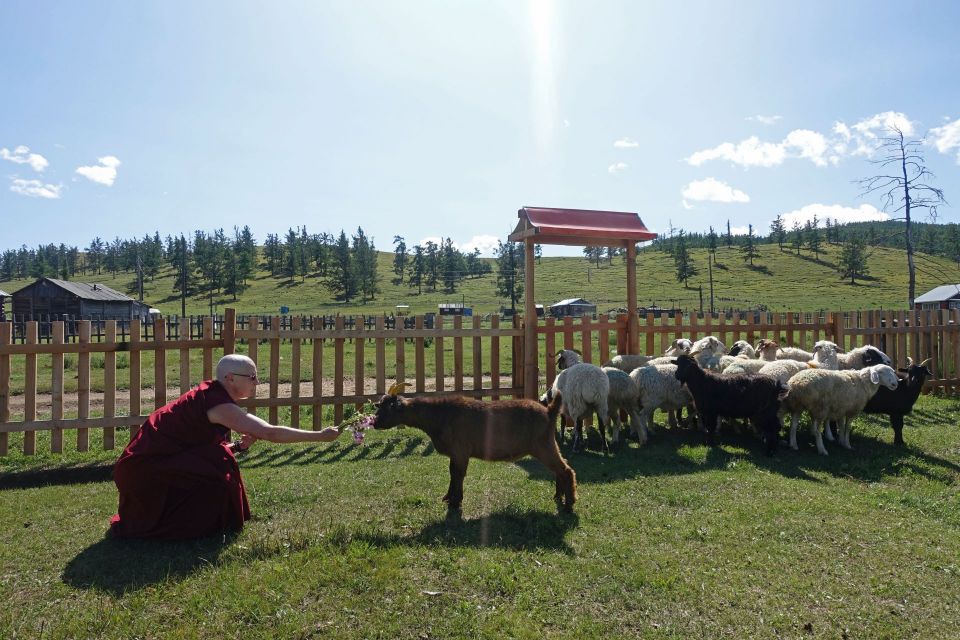
Ven. Thubten Gyalmo and liberated animals, Bulgan province, Northern Mongolia, August 2019. Photo by Ianzhina Bartanova.
In August 2019, Ganden Do Ngag Shedrup Ling, the FPMT center in Ulaanbaatar, Mongolia, successfully liberated four male goats and ten male sheep. They now have a new home in Bulgan province, Northern Mongolia, approximately 400 kilometers (248 miles) from the capital Ulaanbaatar, and are in a peaceful environment with beautiful green surroundings. They are now no longer in danger of being eaten. Center director Ianzhina Bartanova shares the story.
Clearly, the tradition to liberate animals from life-threatening conditions was well-known and practiced in Mongolia in the past. However, nowadays it is so rare, and many people do not have an awareness of this. But Ven. Thubten Gyalmo, the FPMT resident teacher at Ganden Do Ngag Shedrup Ling, is sharing information about animal liberation via radio in Mongolia and during her weekly classes at the center in Ulaanbaatar.
The reality in Mongolia is that there is a high consumption of meat. It is one of the main reasons that seven years ago Lama Zopa Rinpoche recommended that the Mongolian center host a 100 million mani retreat on an annual basis. (A 100 million mani retreat is where retreatants recite the Chenrezig mantra OM MANI PADME HUM a 100 million times.) In addition to the mani retreats, Ganden Do Ngag Shedrup Ling has initiated an animal liberation, the very first one for the past twenty years. The animals were rescued from the butcher market during Mongolia’s national festival of Naadam, a time of great celebration when mutton dishes are widely served.
The liberation combined two traditions: the Mongolian one and lineage of Lama Zopa Rinpoche. According to Mongolian tradition, only male sheep and goats should be liberated, and a special animal liberation sutra must be recited for removing obstacles, obtaining longevity, and attainment of nirvana. Also this tradition requires one to sprinkle blessed water over the animals, to put mani pills inside their mouths, anoint their heads and hooves with some oil, and shower flower petals over them while reciting auspicious mantras. Moreover, our liberated animals have their own ID cards and names. Male sheep are called Yamuchil One, Yamuchil Two, etc., up to number ten, and male goats are called Tsevel One, Two, Three, and Four respectively. These names are mentioned in the sutra.
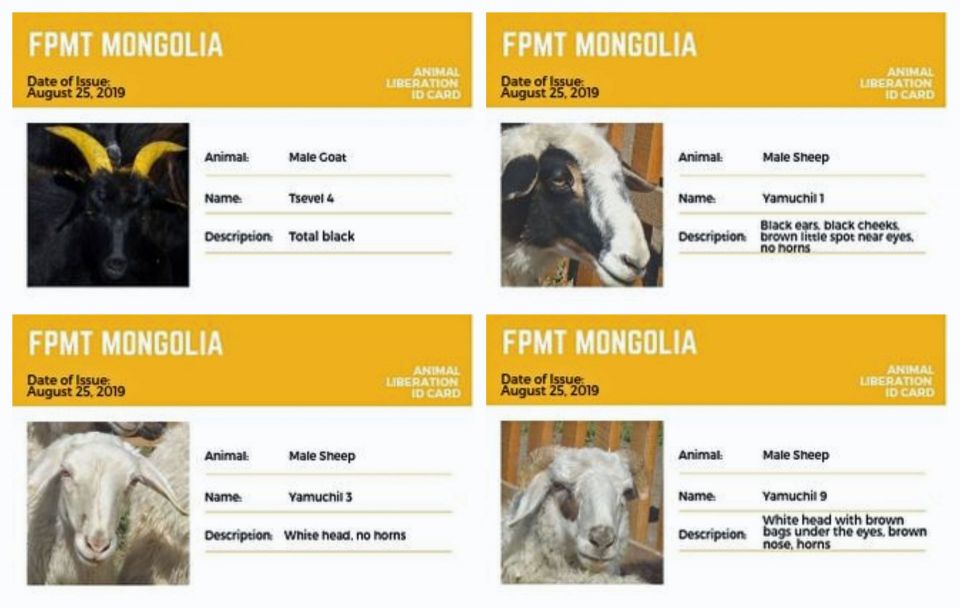
Liberated animals ID cards, Mongolia, August 2019. Photo by Ianzhina Bartanova.
Traditionally, liberated Mongolian sheep were not shorn so people could easily recognize them from their long fleece. Upon the advice of the local herder and drawing from today’s practice of animal husbandry, the health of the sheep will be compromised if not shorn, especially during the summer heat. Therefore, we will shear them at a suitable time. We had quite a chuckle imagining sheep with very long “wool,” their limbs and horns “massaged” with oil, and having passed through some detox diet of mani pills, and emerging from a flower-spa procedure. So we called them “hippie animals,” our Mongolian flower children.
Following Lama Zopa Rinpoche’s advice, various preliminary prayers, mantra recitations, and other practices were done and concluded with special FPMT dedication prayers. We had a beautiful altar with a Buddha statue, sutras, stupas, and tsa-tsas arranged in the middle of their new home so animals could do korwa around the altar. It was challenging—however quite fun—to lead them in their first circumambulation.
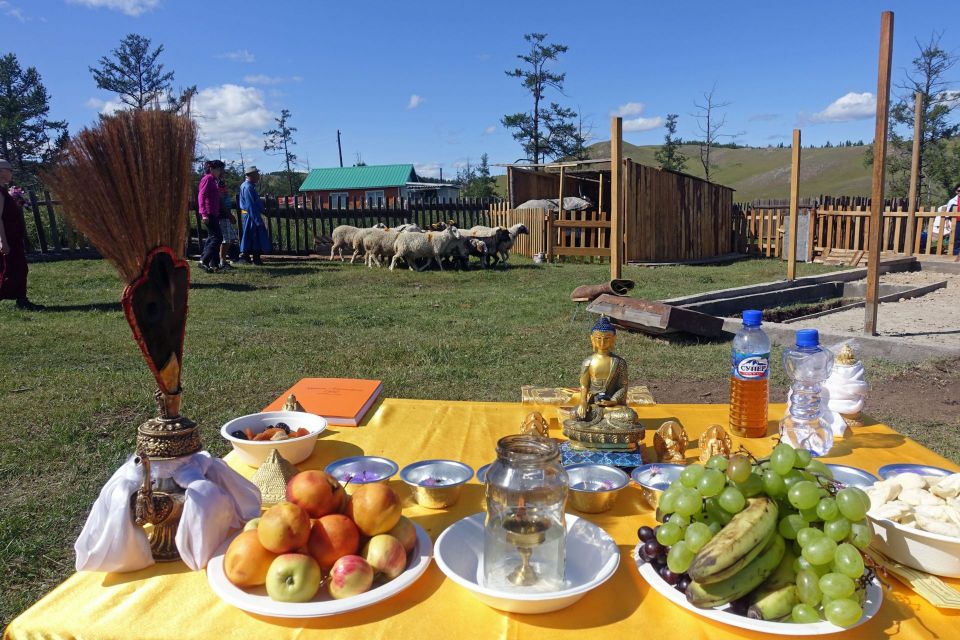
First korwa with the liberated animals, Bulgan province, Northern Mongolia, August 2019. Photo by Ianzhina Bartanova.
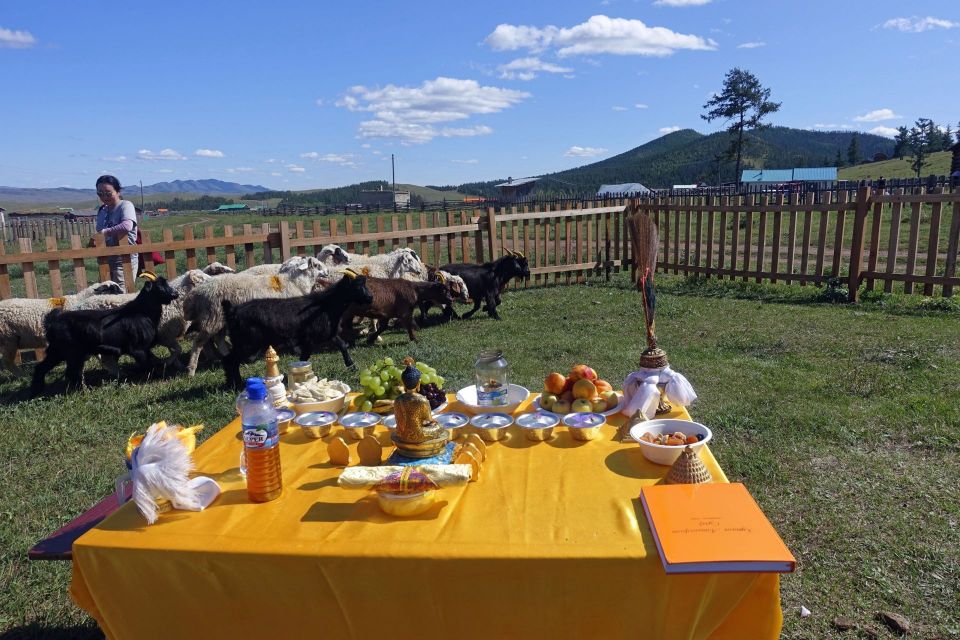
Third korwa with the liberated animals, Bulgan province, Northern Mongolia, August 2019. Photo by Ianzhina Bartanova.
During the auspicious 25th lunar day, Idgaa Choinzinling monks and Dolma Ling nuns led a naga puja near the local water source and a Lama Chopa puja in the local herder Jigmed’s ger. Early in the morning while doing the naga puja, we were blessed with a clear blue sky and the appearance of the sun and moon at the same time; a thangka painting became a reality.
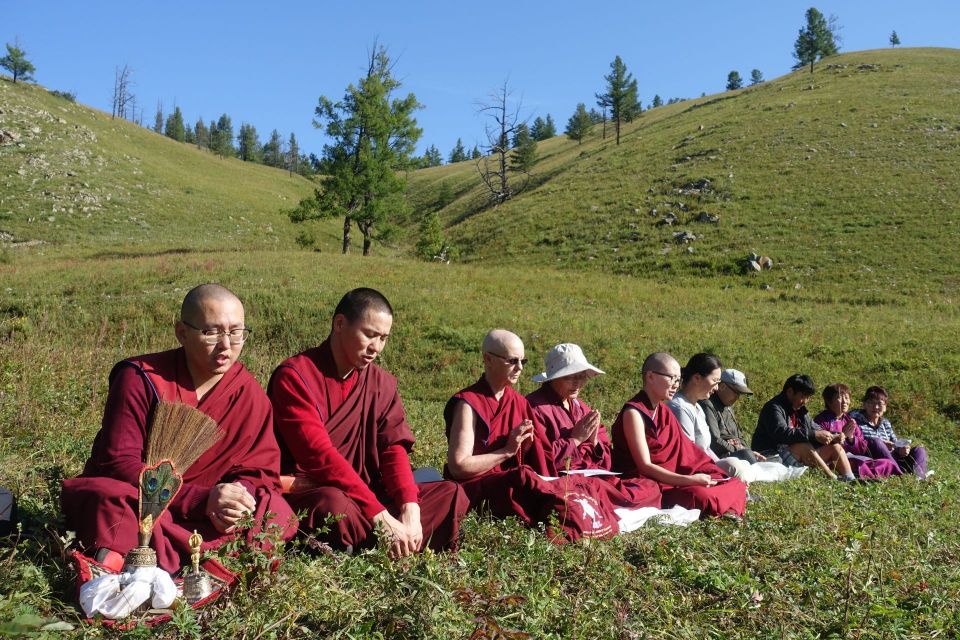
Monks and nuns leading a Naga puja, Bulgan province, Northern Mongolia, August 2019. Photo by Ianzhina Bartanova.
The Lama Chopa puja was done in a traditional tent (ger or yurt) with around twenty participants. It was amazing how such a small ger could fit so many people.
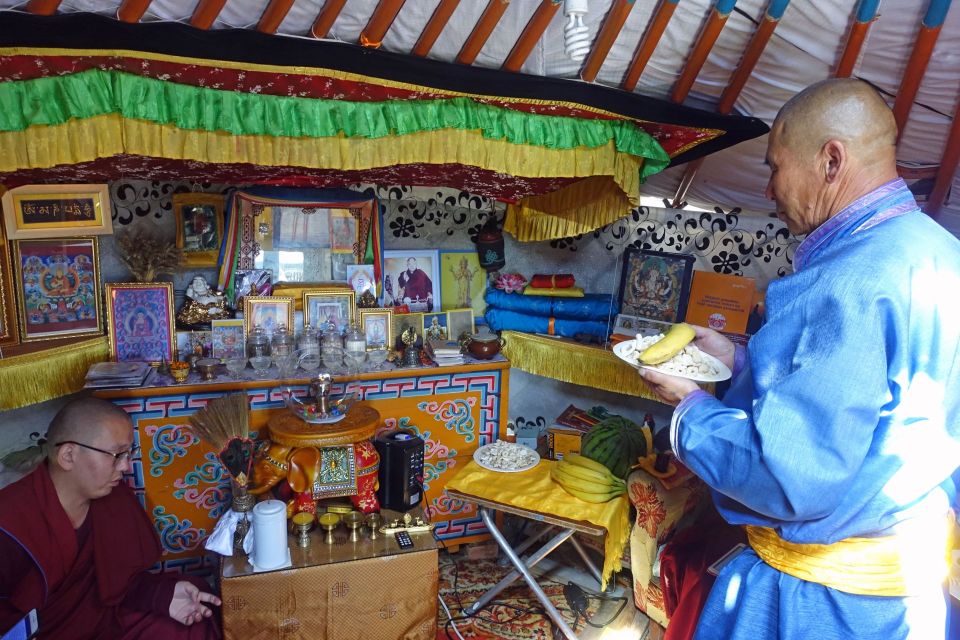
Herder Jigmed offering tsog, Bulgan province, Northern Mongolia, August 2019. Photo by Ianzhina Bartanova.
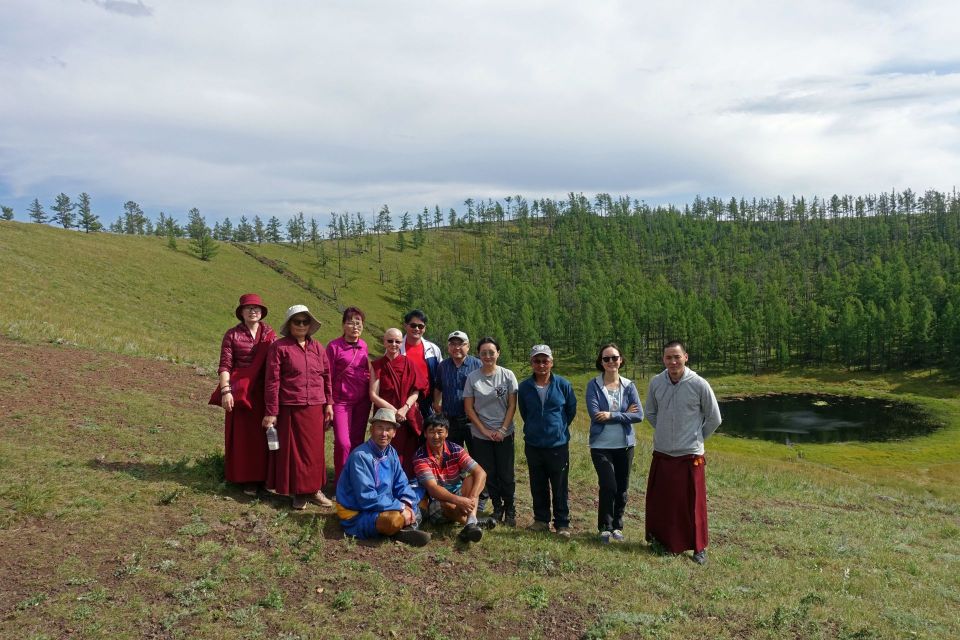
Animal liberation team with some local residents: Ani Choinzom, Ani Cunchen, local student, Ani Gyalmo, local driver, animal liberation coordinator Munkhtuvshin, spiritual program coordinator Khulan, local driver, center director Ianzhina, monk Zoksonbaatar, herder Jigmed and his friend posing on top of an extinct volcano’s crater, Bulgan province, Northern Mongolia, August 2019. Photo courtesy of Ianzhina Bartanova.
Special thanks to our local herder Jigmed, who has kindly offered to take care of the animals. Jigmed has been participating in 100 million mani retreats in Ulaanbaatar since 2013, and he was very inspired by Lama Zopa Rinpoche’s teachings on kindness to animals. Jigmed specially built the fence around his ger and will provide all necessary supplies and care to several Tsevels and Yamuchils. We are also very grateful to local and foreign sponsors, and we encourage everyone to participate in our virtuous activities of saving animals’ lives next year. Let’s make a Dharma herd!
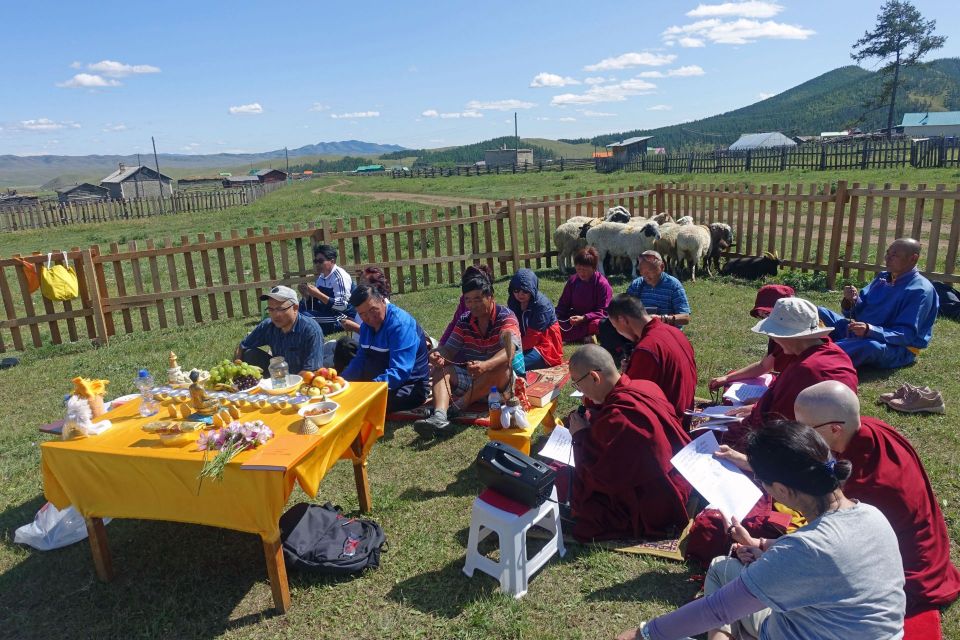
Animal liberation practice, Bulgan province, Northern Mongolia, August 2019. Photo by Ianzhina Bartanova.
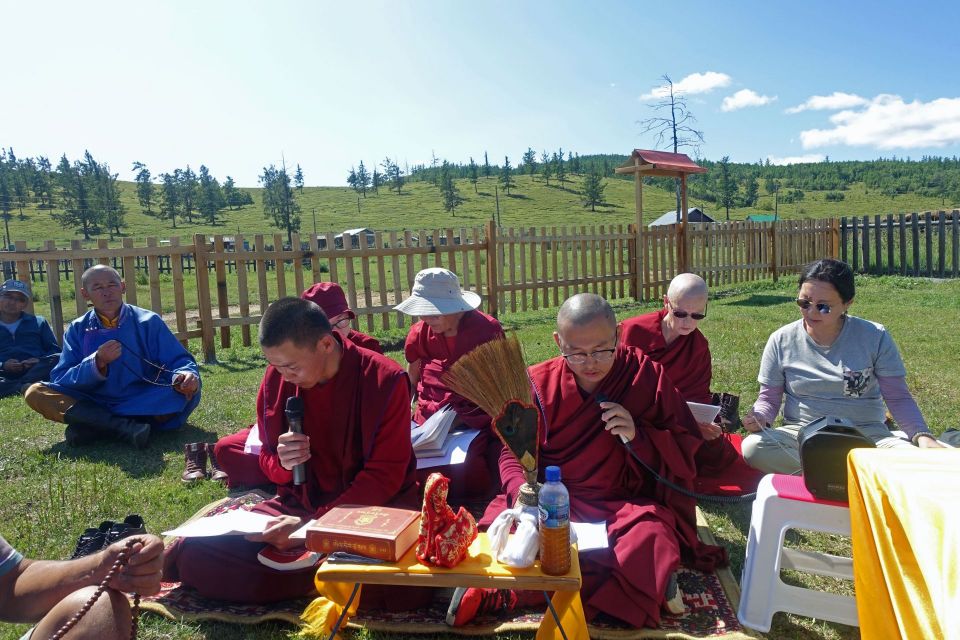
Monks reciting prayers through a loud speaker, Bulgan province, Northern Mongolia, August 2019. Photo by Ianzhina Bartanova.
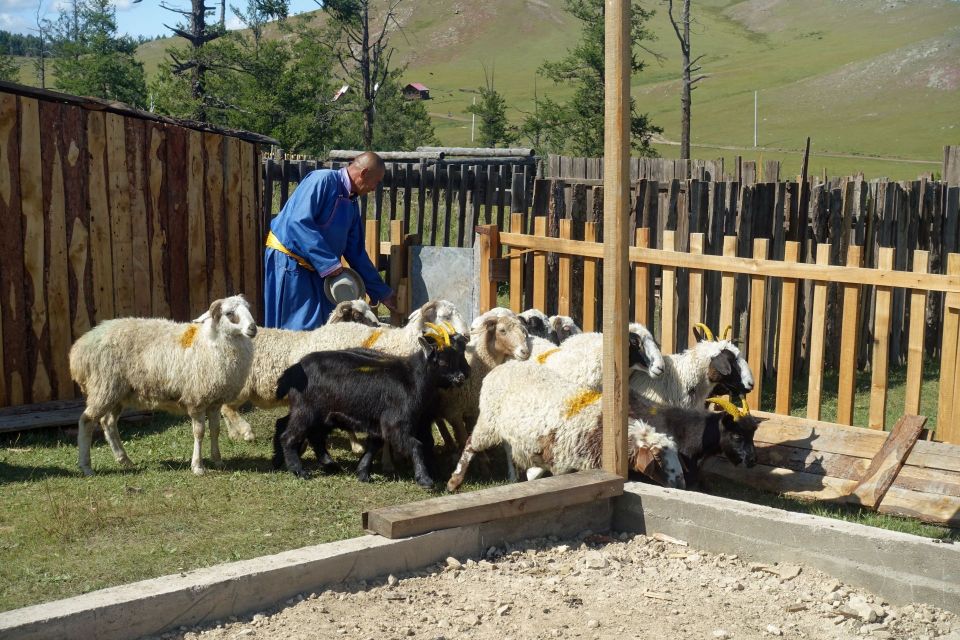
Jigmed and our dear animals, Bulgan province, Northern Mongolia, August 2019. Photo by Ianzhina Bartanova.
Animal blessing practice can be done by students on their own, in other words, a teacher or ordained Sangha member is not needed to lead the practice. For more on practices to benefit animals, see:
https://fpmt.org/education/prayers-and-practice-materials/benefiting-animals-practices-and-advice/
For more information about Ganden Do Ngag Shedrup Ling, visit their website:
http://www.fpmtmongolia.org/shedrub-ling-center
FPMT.org and Mandala Publications brings you news of Lama Zopa Rinpoche and of activities, teachings, and events from over 160 FPMT centers, projects, and services around the globe. If you like what you read, consider becoming a Friend of FPMT, which supports our work.
28

Nalanda monks viewing the property they hope to transform into Maitreya Pure Land, Lavaur, France. Photo courtesy of Nalanda Monastery.
Two monks from Nalanda Monastery are currently touring North America to talk about a new project to create Maitreya Pure Land. The monastery, which is an FPMT affiliate located in the South of France, has an opportunity to buy neighboring property and create a place for semi-isolated retreat. You can read more about the project in Mandala‘s just-published article “Nalanda Monastery’s New Project: Maitreya Pure Land.”
While on their North American tour, the two Nalanda monks, Vens. Gyalten and Tendar, are sharing information on the Maitreya Pure Land project and raising funds for it. The monks have already visited three California FPMT centers—Tse Chen Ling, Ocean of Compassion, and Land of Medicine Buddha—and Kachoe Dechen Ling, Lama Zopa Rinpoche’s house in Aptos. The tour, which is schedule from October to December, is taking the monks to the US states of California, Wyoming, Colorado, New Mexico, Oregon, Florida, and Vermont, and the capital, Washington, D.C. More locations may be added soon.
Read the new article “Nalanda Monastery’s New Project: Maitreya Pure Land”:
https://fpmt.org/mandala/in-depth-stories/nalanda-monastery/
Learn more about Nalanda Monastery’s Maitreya Pure Land project, including how to invite Vens. Gyalten and Tendar to visit during their tour and how to offer support:
https://maitreya.nalanda-monastery.eu/
Follow Vens. Gyalten and Tendar on their North American tour on their Facebook page:
https://www.facebook.com/nalandastour/
FPMT.org and Mandala Publications brings you news of Lama Zopa Rinpoche and of activities, teachings, and events from over 160 FPMT centers, projects, and services around the globe. If you like what you read, consider becoming a Friend of FPMT, which supports our work.
- Home
- News/Media
- Study & Practice
- About FPMT Education Services
- Latest News
- Programs
- New to Buddhism?
- Buddhist Mind Science: Activating Your Potential
- Heart Advice for Death and Dying
- Discovering Buddhism
- Living in the Path
- Exploring Buddhism
- FPMT Basic Program
- FPMT Masters Program
- FPMT In-Depth Meditation Training
- Maitripa College
- Lotsawa Rinchen Zangpo Translator Program
- Universal Education for Compassion & Wisdom
- Online Learning Center
- Prayers & Practice Materials
- Overview of Prayers & Practices
- Full Catalogue of Prayers & Practice Materials
- Explore Popular Topics
- Benefiting Animals
- Chenrezig Resources
- Death & Dying Resources
- Lama Chopa (Guru Puja)
- Lama Zopa Rinpoche: Compendium of Precious Instructions
- Lama Zopa Rinpoche: Life Practice Advice
- Lama Zopa Rinpoche Practice Series
- Lamrim Resources
- Mantras
- Prayer Book Updates
- Purification Practices
- Sutras
- Thought Transformation (Lojong)
- Audio Materials
- Dharma Dates – Tibetan Calendar
- Translation Services
- Publishing Services
- Teachings and Advice
- Find Teachings and Advice
- Lama Zopa Rinpoche Advice Page
- Lama Zopa Rinpoche: Compendium of Precious Instructions
- Lama Zopa Rinpoche Video Teachings
- ༧སྐྱབས་རྗེ་བཟོད་པ་རིན་པོ་ཆེ་མཆོག་ནས་སྩལ་བའི་བཀའ་སློབ་བརྙན་འཕྲིན།
- Podcasts
- Lama Yeshe Wisdom Archive
- Buddhism FAQ
- Dharma for Young People
- Resources on Holy Objects
- Ways to Offer Support
- Centers
- Teachers
- Projects
- Charitable Projects
- Make a Donation
- Applying for Grants
- News about Projects
- Other Projects within FPMT
- Support International Office
- Projects Photo Galleries
- Give Where Most Needed
- FPMT
- Shop
Translate*
*powered by Google TranslateTranslation of pages on fpmt.org is performed by Google Translate, a third party service which FPMT has no control over. The service provides automated computer translations that are only an approximation of the websites' original content. The translations should not be considered exact and only used as a rough guide.Proper guru devotion – correct devotion to your virtuous friends – allows you to actualize successfully all the steps of the path to enlightenment, from the perfect human rebirth up to buddhahood itself.







